Colonial front porches embody timeless American architectural elegance, serving as welcoming gateways that blend historical charm with practical functionality. These distinctive outdoor spaces reflect the symmetrical design principles and understated sophistication that define colonial-style homes. From grand covered porches with classical columns to intimate porticos featuring period-appropriate details, colonial front porches offer endless possibilities for enhancing curb appeal. Whether you're renovating an authentic colonial home or adding colonial character to a modern build, these design ideas will help you create an inviting entrance that honors traditional aesthetics while meeting contemporary lifestyle needs.
1. Colonial Front Porch with Classic Fluted Columns

Transform your entrance with traditional fluted columns that capture authentic colonial architecture. These columns feature distinctive vertical grooves running along their length, creating visual depth and elegant shadows that enhance the porch's stately appearance. Available in wood, fiberglass, or composite materials, fluted columns typically range from 8 to 12 inches in diameter with a subtle taper toward the top. The fluting traditionally starts about 9 inches from the column's top and extends to approximately 4 inches from the base, allowing for proper proportions and field trimming. When paired with classical capitals and bases, these columns create the perfect foundation for a covered porch that exudes historical authenticity while providing excellent structural support for your roof system.
2. Colonial Front Porch Farmer's Style Design
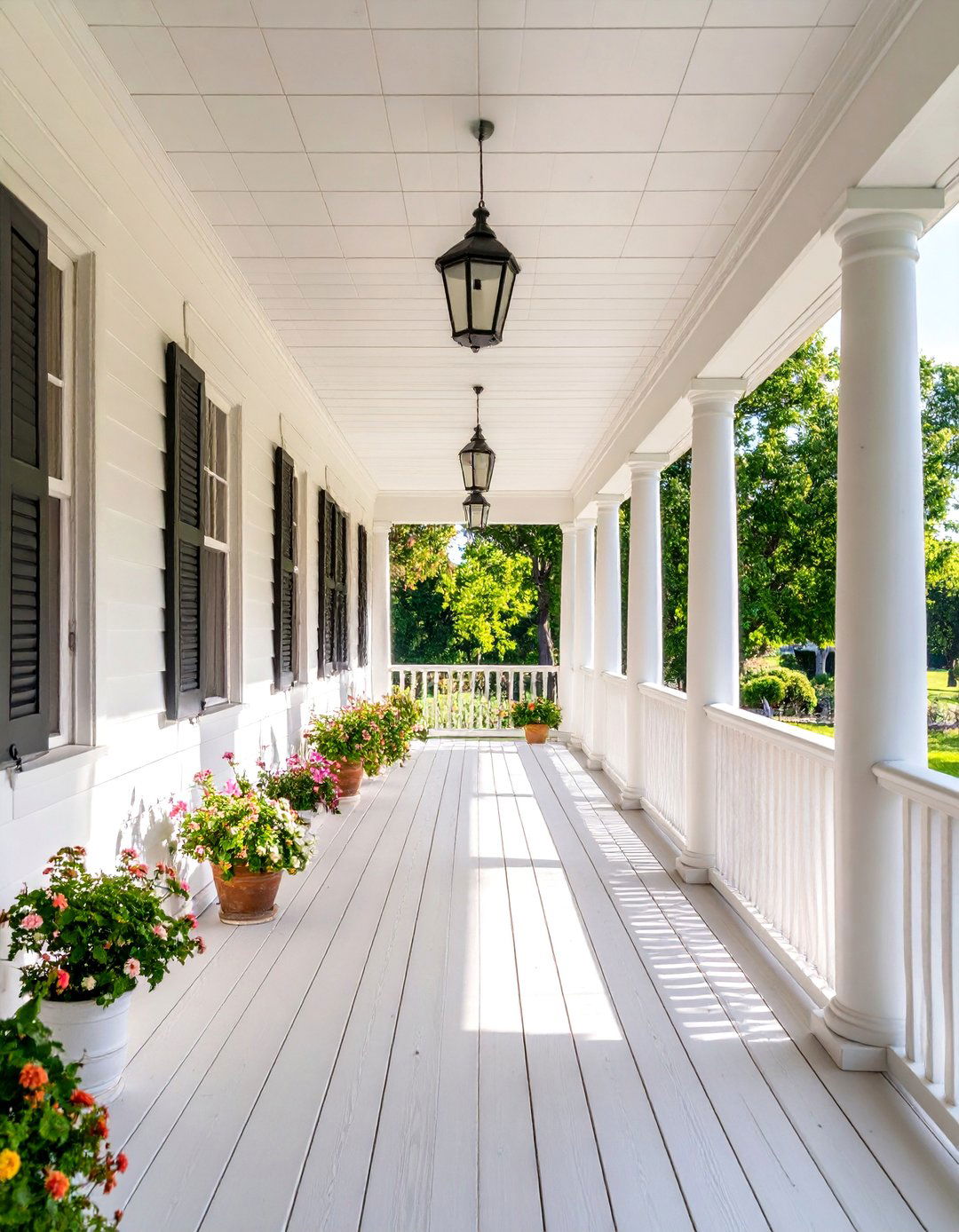
Create a quintessential New England look with a full-width farmer's porch that spans your home's entire front facade. This design features a low-pitched roof supported by evenly spaced columns, typically positioned every 8 to 10 feet for optimal structural integrity and visual balance. The porch floor should extend at least 6 feet from the house to provide adequate space for furniture and foot traffic. Traditional farmer's porches include simple square or turned wooden posts, painted white to match the home's trim, and basic railings that maintain clean lines. Consider adding a beadboard ceiling painted in soft blue or white to enhance the authentic farmhouse aesthetic while providing a classic backdrop for pendant lighting fixtures.
3. Colonial Front Porch with Symmetrical Entry Design
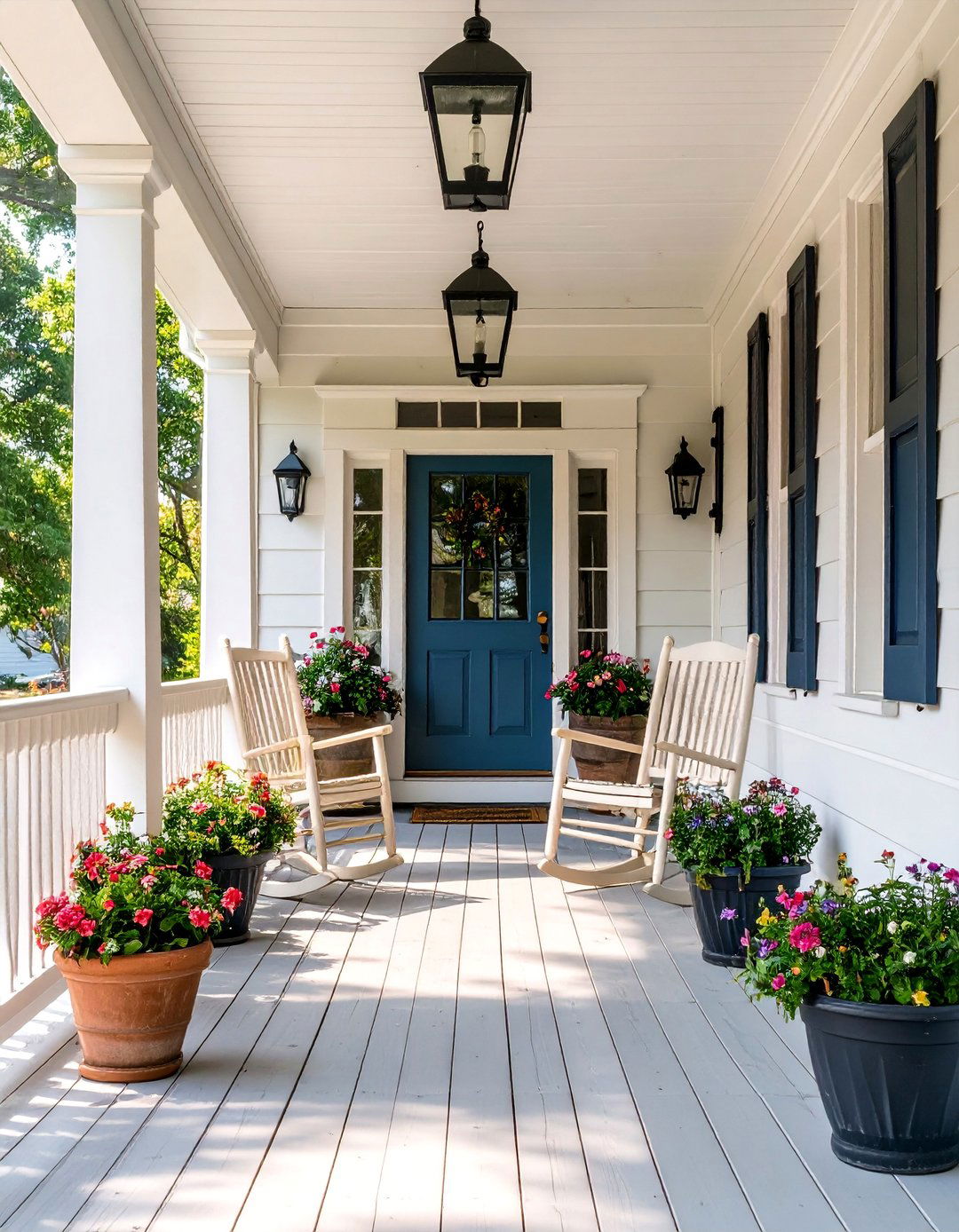
Emphasize your home's inherent symmetry with a perfectly balanced porch design that features matching elements on either side of the central front door. Install identical lantern-style light fixtures flanking the entrance, complemented by symmetrical planters or urns filled with seasonal greenery. The porch should feature an even number of columns or posts, typically four or six, positioned to create equal spacing and visual harmony. Add matching outdoor furniture arrangements, such as two rocking chairs with a small side table between them, positioned symmetrically on either side of the entry path. This balanced approach reinforces the colonial architectural principle of proportion while creating an orderly, welcoming appearance that guests will appreciate.
4. Colonial Front Porch Portico Addition
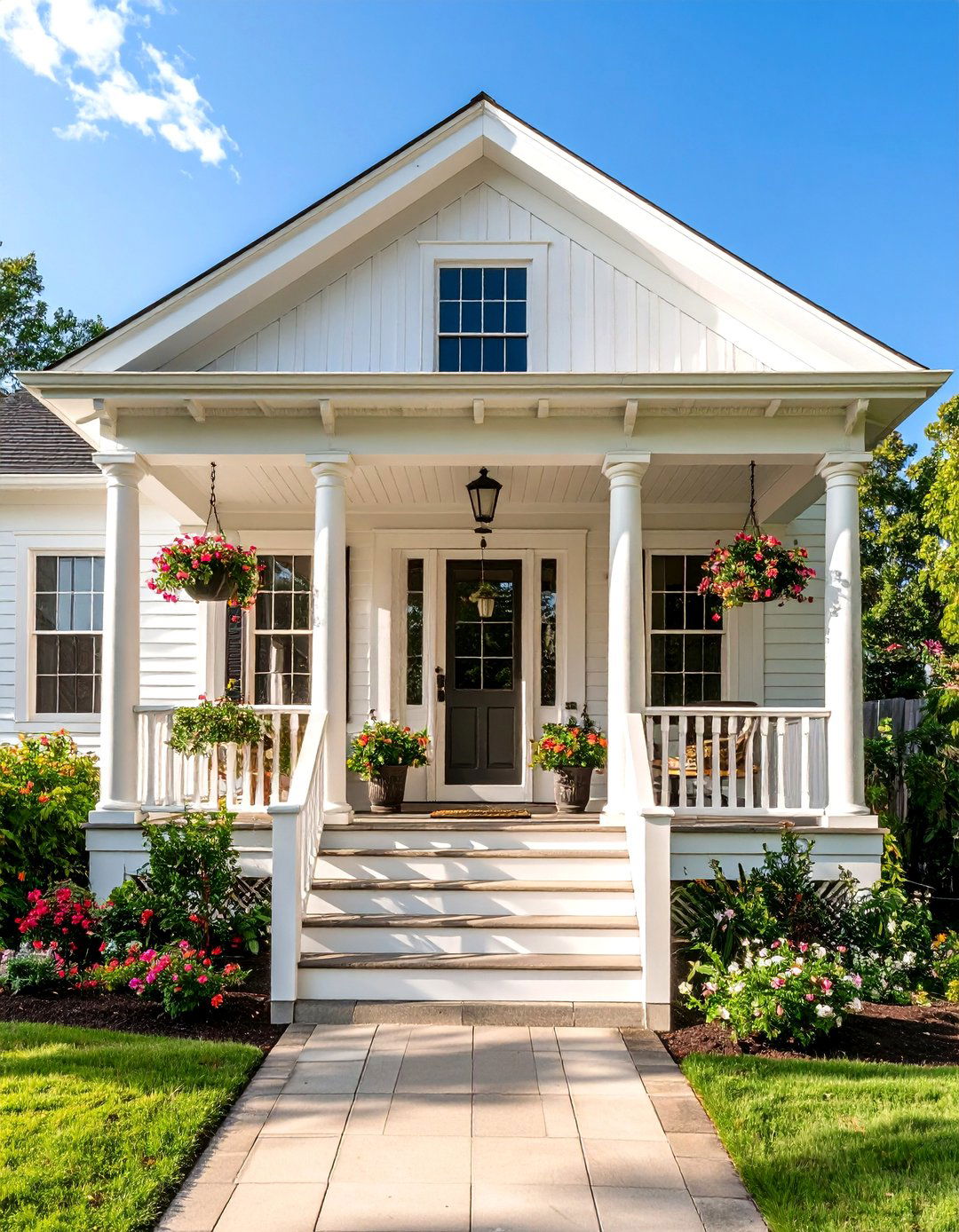
Enhance a modest colonial entrance with an elegant portico that adds architectural interest without overwhelming the home's proportions. A portico typically extends 4 to 6 feet from the house and features two to four columns supporting a triangular pediment or simple shed roof. Choose columns that complement your home's scale—8-inch diameter columns work well for smaller homes, while larger colonials can accommodate 10 to 12-inch columns. The portico should be wide enough to frame the front door generously, typically spanning 8 to 12 feet across. Consider adding decorative brackets beneath the roof line and install period-appropriate lighting fixtures to complete the classical look while providing practical weather protection for your entrance.
5. Colonial Front Porch with Traditional Lantern Lighting
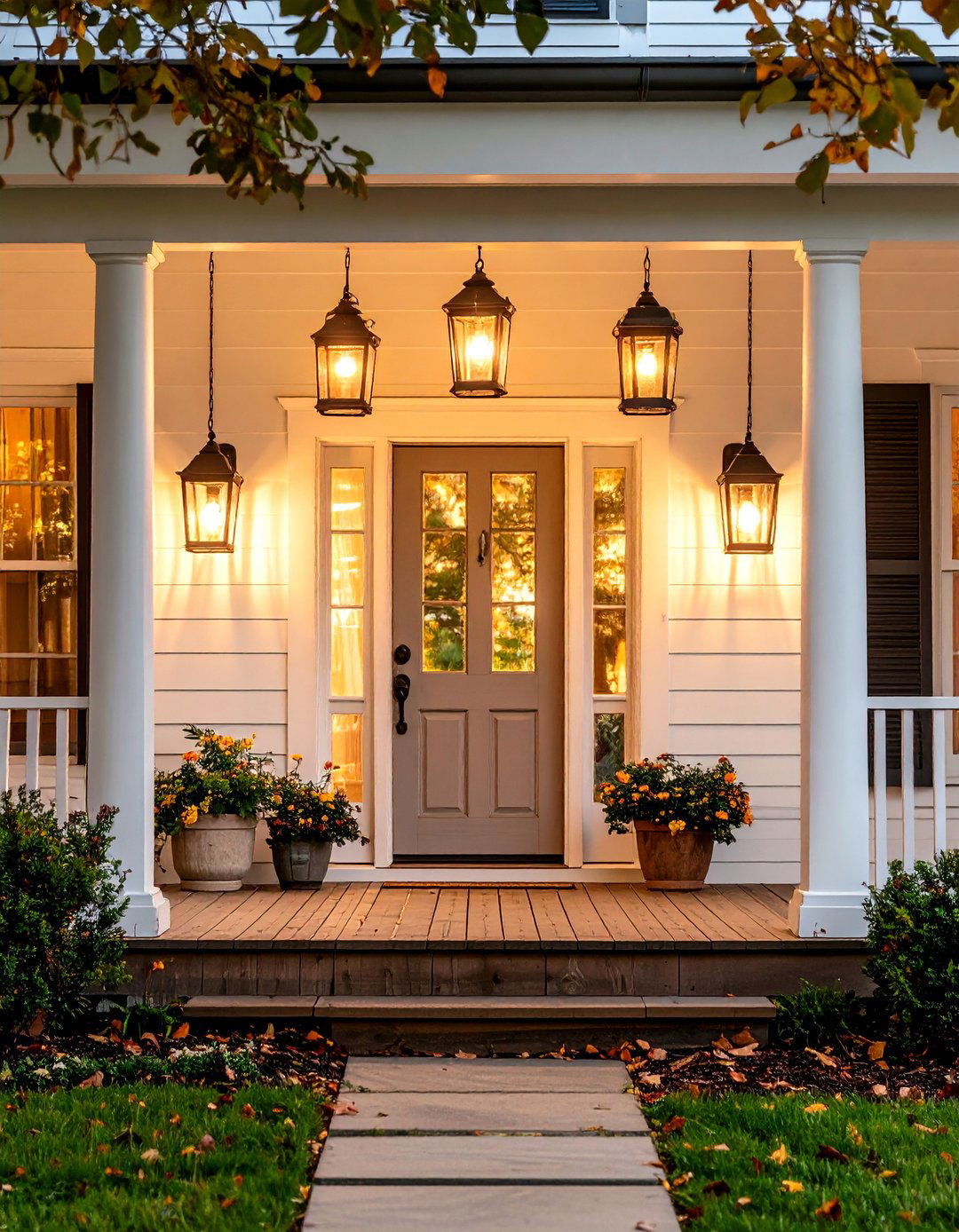
Illuminate your porch with authentic colonial-style lantern fixtures that provide both functional lighting and historical charm. Choose copper or black metal lanterns with clear or seeded glass panels, mounted on either side of the front door at eye level for optimal illumination. For larger porches, add hanging lanterns suspended from the ceiling on decorative chains, positioned to provide even light distribution across seating areas. Consider installing lantern posts along walkways or at the porch's perimeter to create a cohesive lighting scheme. Traditional colonial lanterns should feature simple geometric shapes without ornate Victorian details, maintaining the period's preference for understated elegance while using LED bulbs for energy efficiency and longevity.
6. Colonial Front Porch with White Painted Railings
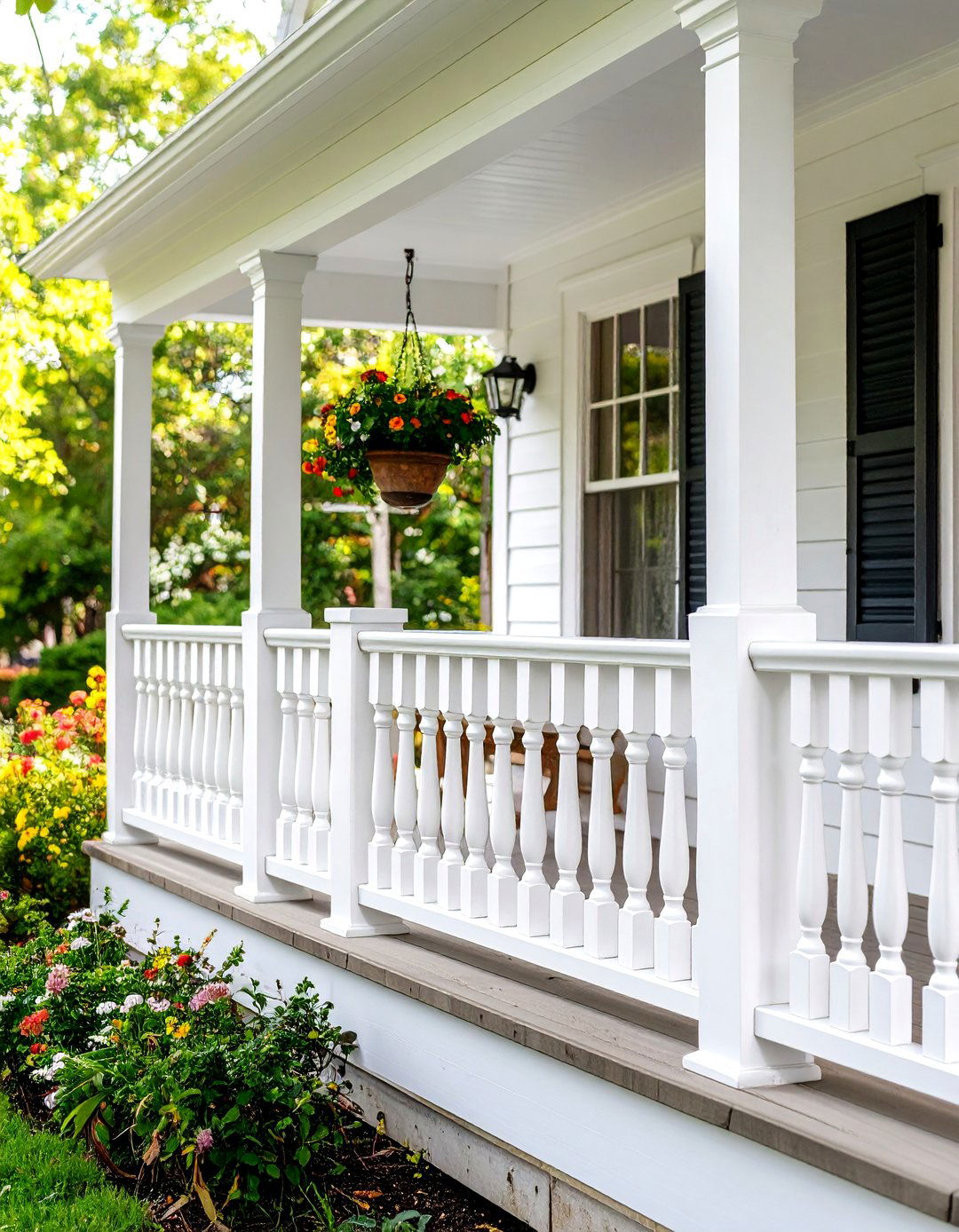
Design classic white railings that complement your colonial home's trim while providing safety and visual definition. Traditional colonial railings feature simple balusters spaced 4 to 6 inches apart, topped with a smooth handrail and supported by a bottom rail approximately 4 inches from the porch floor. Choose between square or turned balusters for different aesthetic effects—square balusters offer clean, geometric lines while turned balusters provide subtle decorative interest. The railing height should measure 36 inches for optimal comfort and code compliance. Paint railings in crisp white to match window trim and porch columns, creating visual continuity across your home's exterior while maintaining the colonial preference for monochromatic color schemes that emphasize architectural form over decorative flourishes.
7. Colonial Front Porch with Brick Foundation Elements
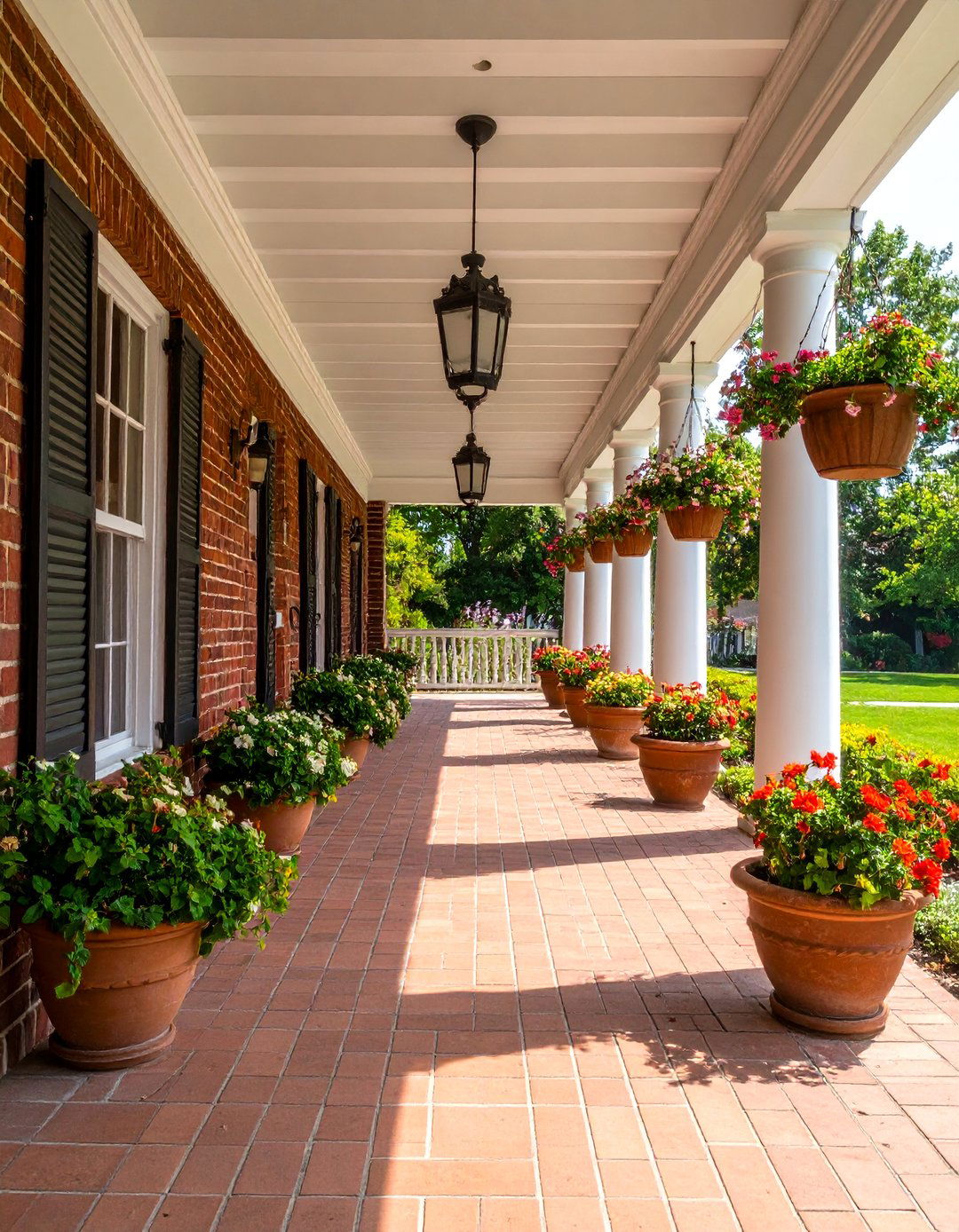
Incorporate brick foundation details that ground your porch design and connect it harmoniously with colonial masonry traditions. Build low brick planters flanking the porch steps, typically 18 to 24 inches high, to create defined planting areas for seasonal flowers or evergreen shrubs. Consider adding brick knee walls between porch columns, rising 2 to 3 feet from the floor level, which provide visual weight and architectural substance. Use traditional red brick with white mortar joints to maintain historical accuracy, or choose painted brick in colors that complement your home's exterior palette. These masonry elements should feature simple, clean lines without excessive ornamentation, reflecting the colonial aesthetic's emphasis on functional beauty and enduring craftsmanship that weathers gracefully over time.
8. Colonial Front Porch with Cedar Shake Accents
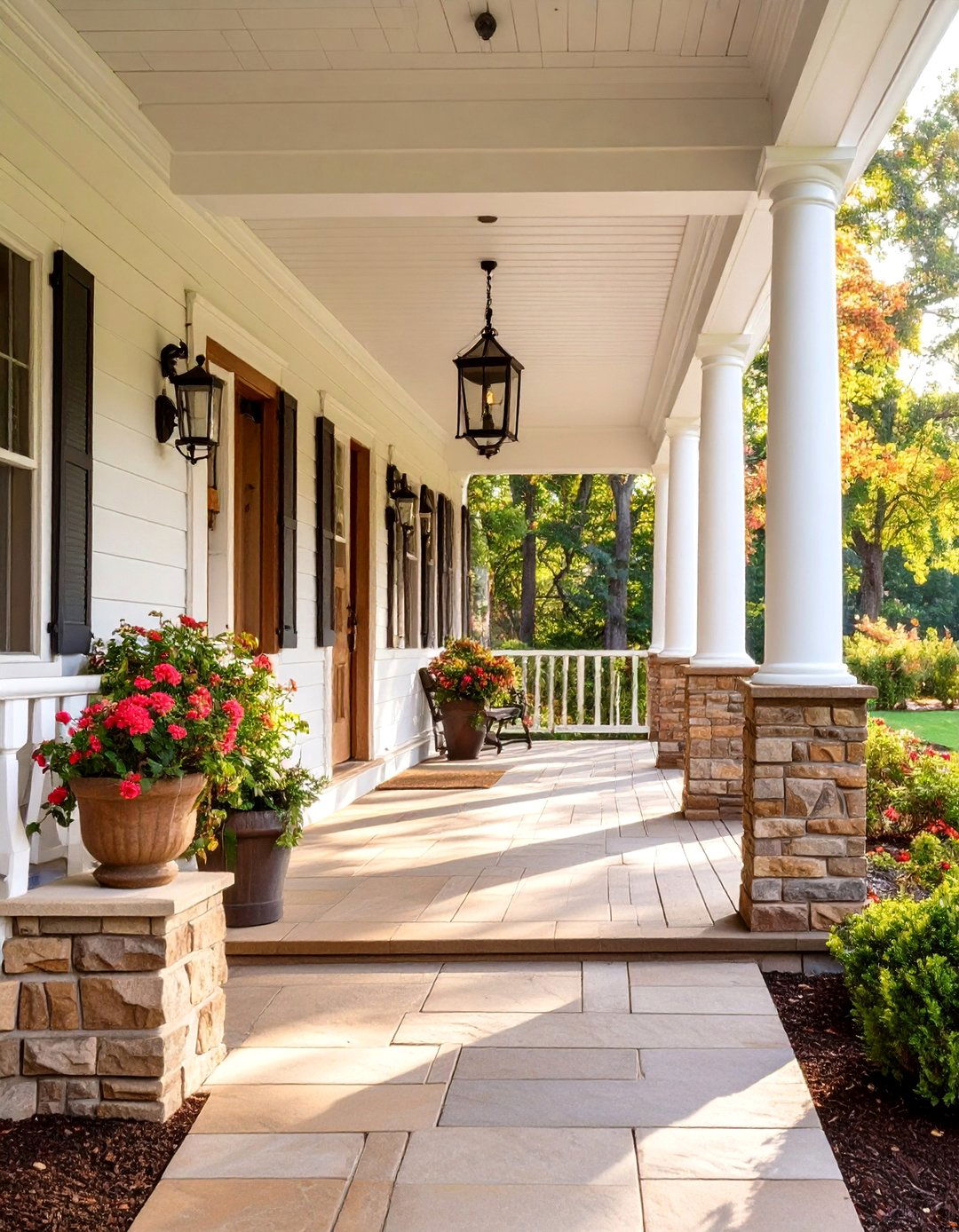
Add authentic texture and visual interest with cedar shake details that honor traditional colonial building materials. Install cedar shakes on porch skirting beneath the floor level, providing an attractive alternative to lattice while maintaining proper ventilation for the crawl space. Consider using cedar shakes on column bases or as wainscoting on porch walls up to 3 feet high, creating natural warmth and historical authenticity. The shakes should be left natural to weather to a silvery gray patina, or stained in earth tones that complement your home's color scheme. This material choice reflects the colonial preference for locally sourced, durable materials while adding dimensional texture that creates appealing shadows and visual depth across your porch's exterior surfaces.
9. Colonial Front Porch with Composite Decking Materials
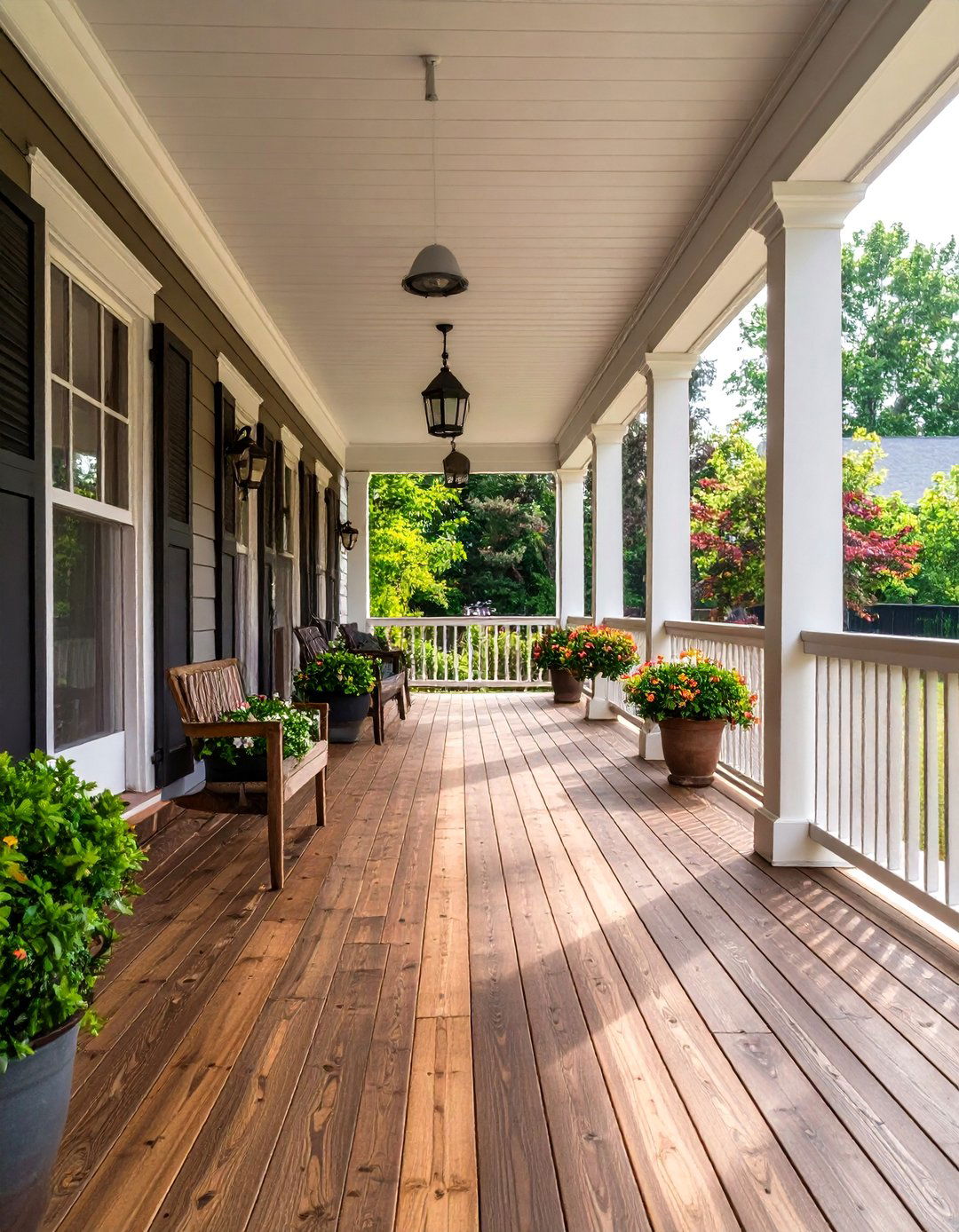
Modernize your colonial porch with composite decking that provides the appearance of natural wood without the maintenance requirements. Choose composite boards in warm gray or weathered brown tones that complement traditional colonial color palettes while offering superior durability against moisture, insects, and temperature fluctuations. Install the decking with proper spacing for drainage and expansion, using hidden fasteners to maintain clean lines. Composite materials allow you to achieve the wide-plank appearance of historical porch floors while meeting contemporary performance standards. This practical choice ensures your porch will maintain its attractive appearance for decades with minimal upkeep, allowing you to focus on enjoying your outdoor space rather than constant maintenance tasks that traditional wood flooring requires.
10. Colonial Front Porch with Dutch Door Entry
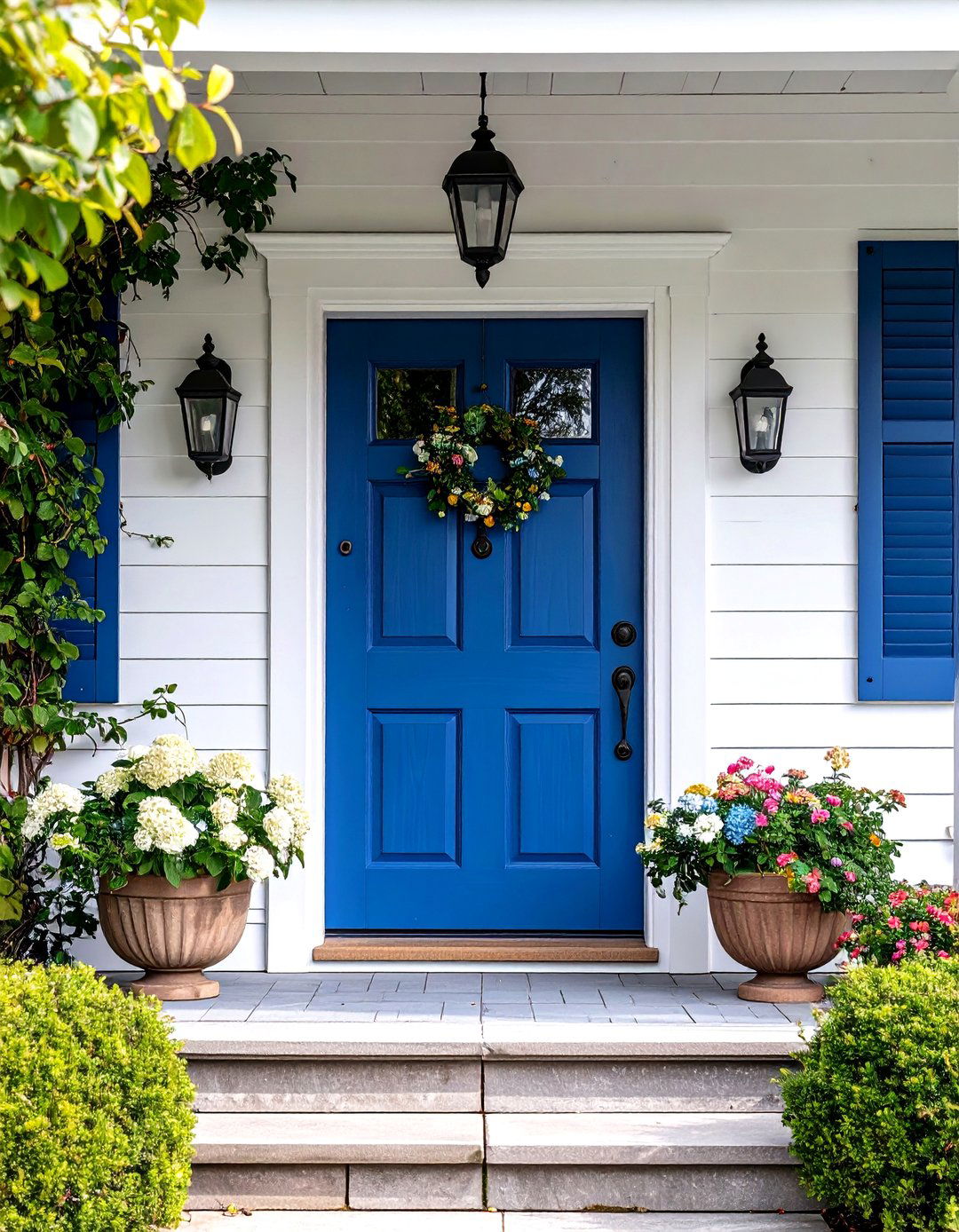
Create an authentic colonial entrance with a Dutch door that allows flexible ventilation while maintaining security and privacy. Traditional Dutch doors feature separate upper and lower halves that open independently, enabling fresh air circulation while keeping pets and children safely contained. Choose a door with raised panels and traditional hardware in oil-rubbed bronze or antique brass finishes that complement the colonial aesthetic. Paint the door in classic colors like deep blue, forest green, or traditional red to create a welcoming focal point against white trim. Install period-appropriate door hardware including thumb latches and strap hinges that reinforce the historical character while providing modern security features for contemporary living needs.
11. Colonial Front Porch with Seasonal Planter Arrangements
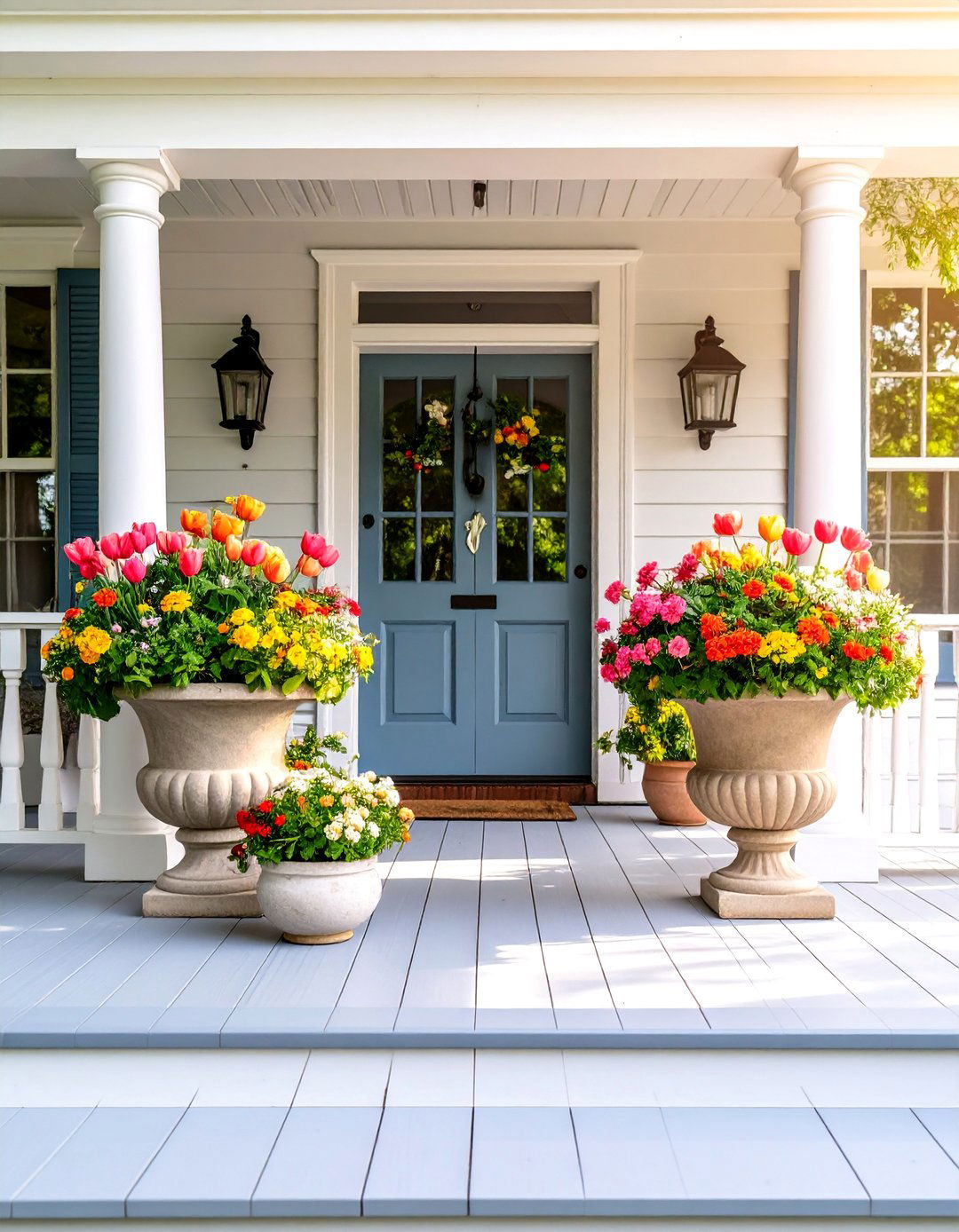
Design flexible planter displays that celebrate each season while maintaining colonial elegance throughout the year. Use large ceramic urns or wooden planters positioned symmetrically on either side of the entrance, filled with seasonal arrangements that complement your home's color scheme. Spring plantings might include tulips and daffodils with trailing ivy, while summer displays feature geraniums or impatiens with sweet potato vine. Fall arrangements can incorporate mums, ornamental cabbage, and small pumpkins, while winter displays might include evergreen boughs with red berries. Choose planters in neutral colors like white, cream, or sage green that won't compete with your seasonal plantings. This approach allows you to refresh your porch's appearance throughout the year while maintaining the restrained elegance characteristic of colonial design.
12. Colonial Front Porch with Traditional Swing Seating
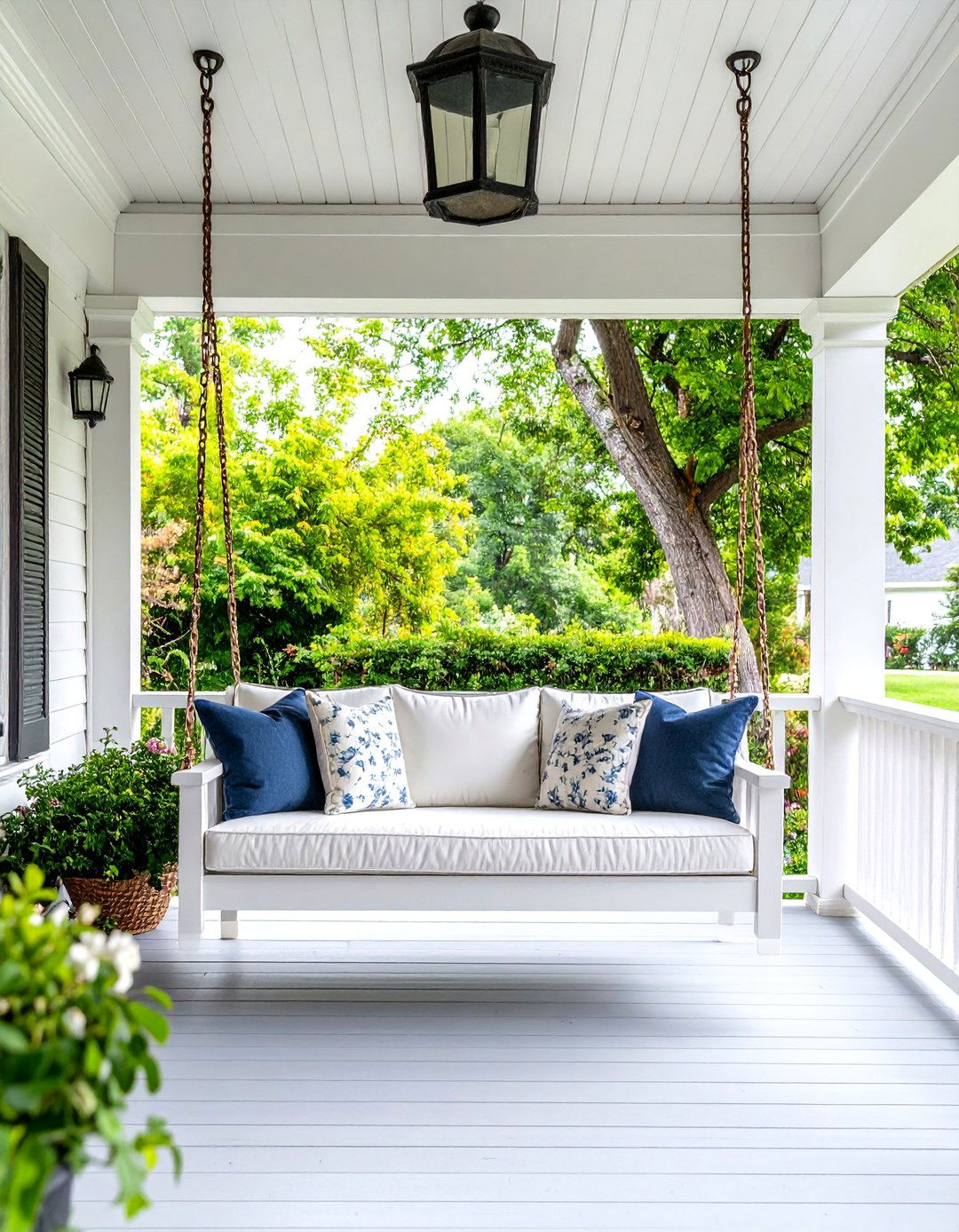
Install a classic porch swing that provides comfortable seating while honoring colonial outdoor living traditions. Choose a wooden swing with simple lines and traditional proportions, typically 4 to 5 feet wide to accommodate two people comfortably. The swing should hang from galvanized chains attached to secure eye bolts in the porch ceiling, positioned at least 24 inches from the wall to allow proper motion. Paint the swing white to match porch trim, or stain it in natural wood tones that complement your porch flooring. Add weather-resistant cushions in classic patterns like stripes or small florals in colonial blue, green, or red. Position the swing to take advantage of pleasant views while providing a comfortable spot for morning coffee or evening relaxation.
13. Colonial Front Porch with Metal Roof Installation
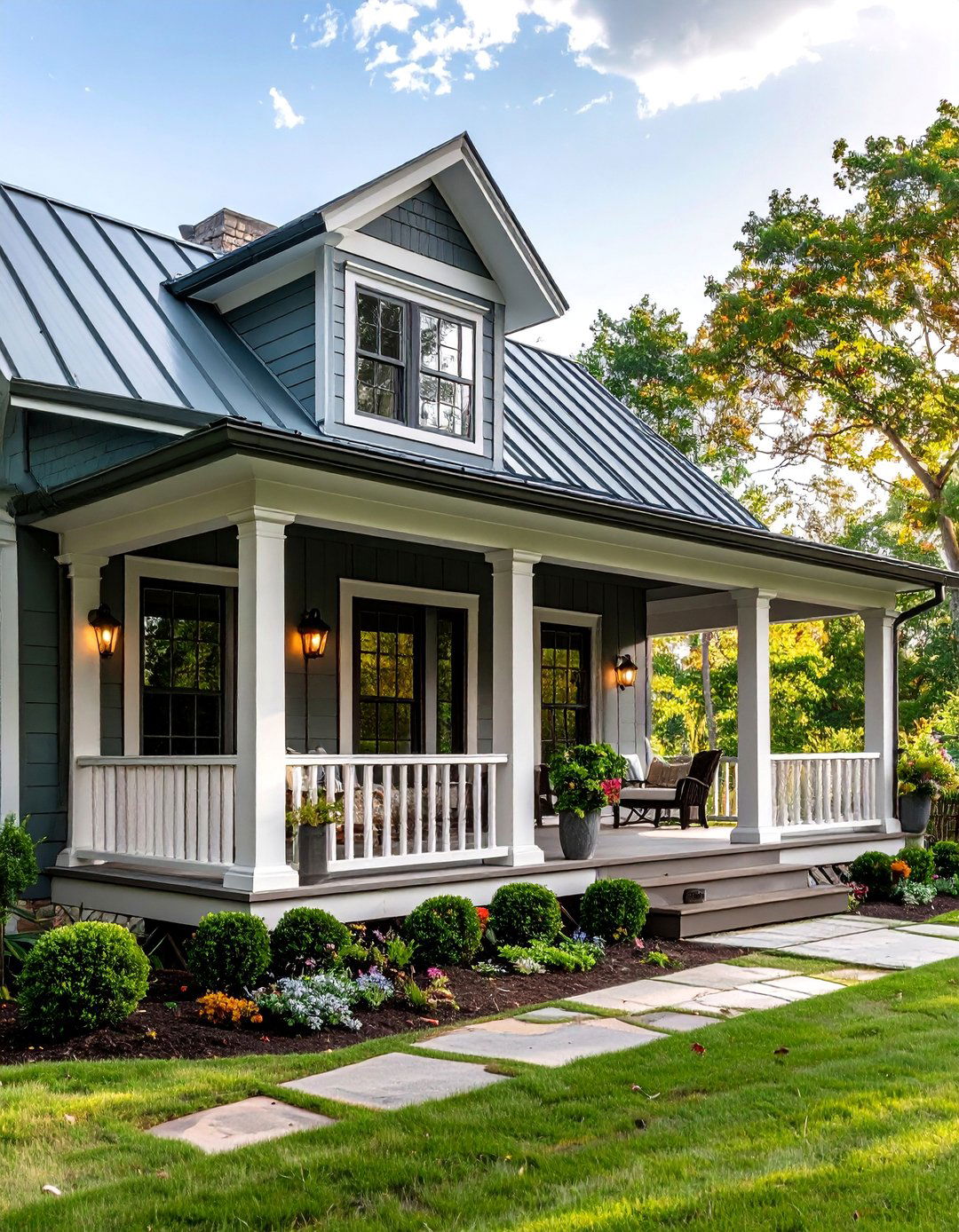
Top your porch with a standing seam metal roof that provides durability while maintaining period-appropriate aesthetics. Metal roofing offers excellent weather protection and longevity, available in colors like black, dark green, or weathered gray that complement colonial exteriors. The standing seam design creates clean vertical lines that emphasize the porch's rectangular geometry while providing superior water shedding capabilities. Install proper underlayment and ensure adequate ventilation to prevent condensation issues. The metal roof should extend beyond the porch's outer edge by 6 to 8 inches to provide weather protection while creating attractive shadow lines. This roofing choice combines historical precedent with modern performance, offering a maintenance-free solution that will protect your porch for decades while enhancing its architectural character.
14. Colonial Front Porch with Decorative Bracket Details
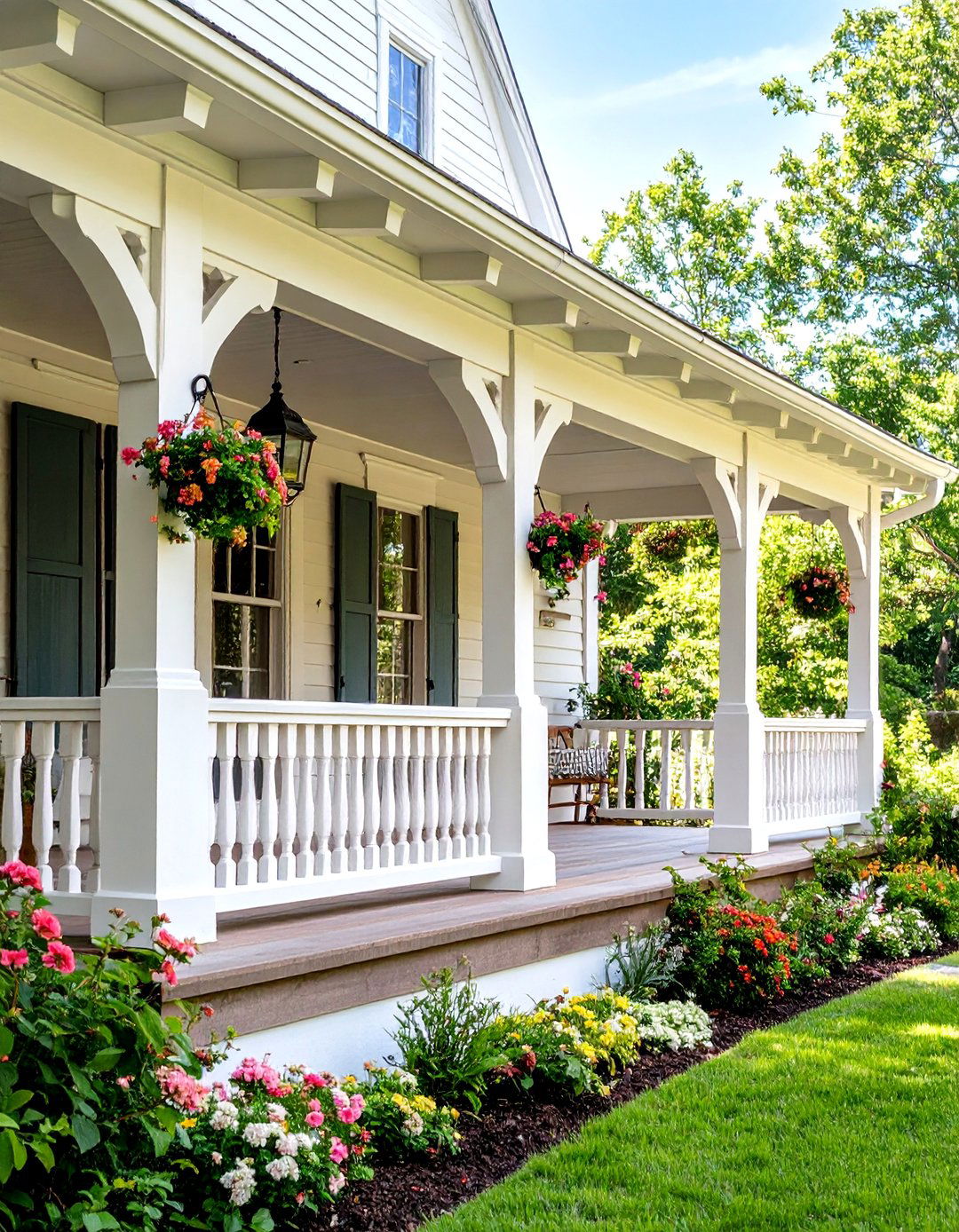
Enhance your porch's visual appeal with traditional wooden brackets that add architectural interest beneath the roofline. These brackets, also called corbels, should feature simple geometric cutouts or gentle curves that reflect colonial craftsmanship without excessive ornamentation. Install brackets at regular intervals along the porch's edge, typically every 4 to 6 feet, ensuring they align with column positions for visual balance. Choose bracket designs that complement your home's scale—larger homes can accommodate more substantial brackets while smaller colonials look best with delicate proportions. Paint brackets white to match trim, or stain them to coordinate with porch columns. These details add depth and shadow lines that enhance the porch's three-dimensional quality while demonstrating the fine woodworking traditions of colonial architecture.
15. Colonial Front Porch with Stone Step Integration
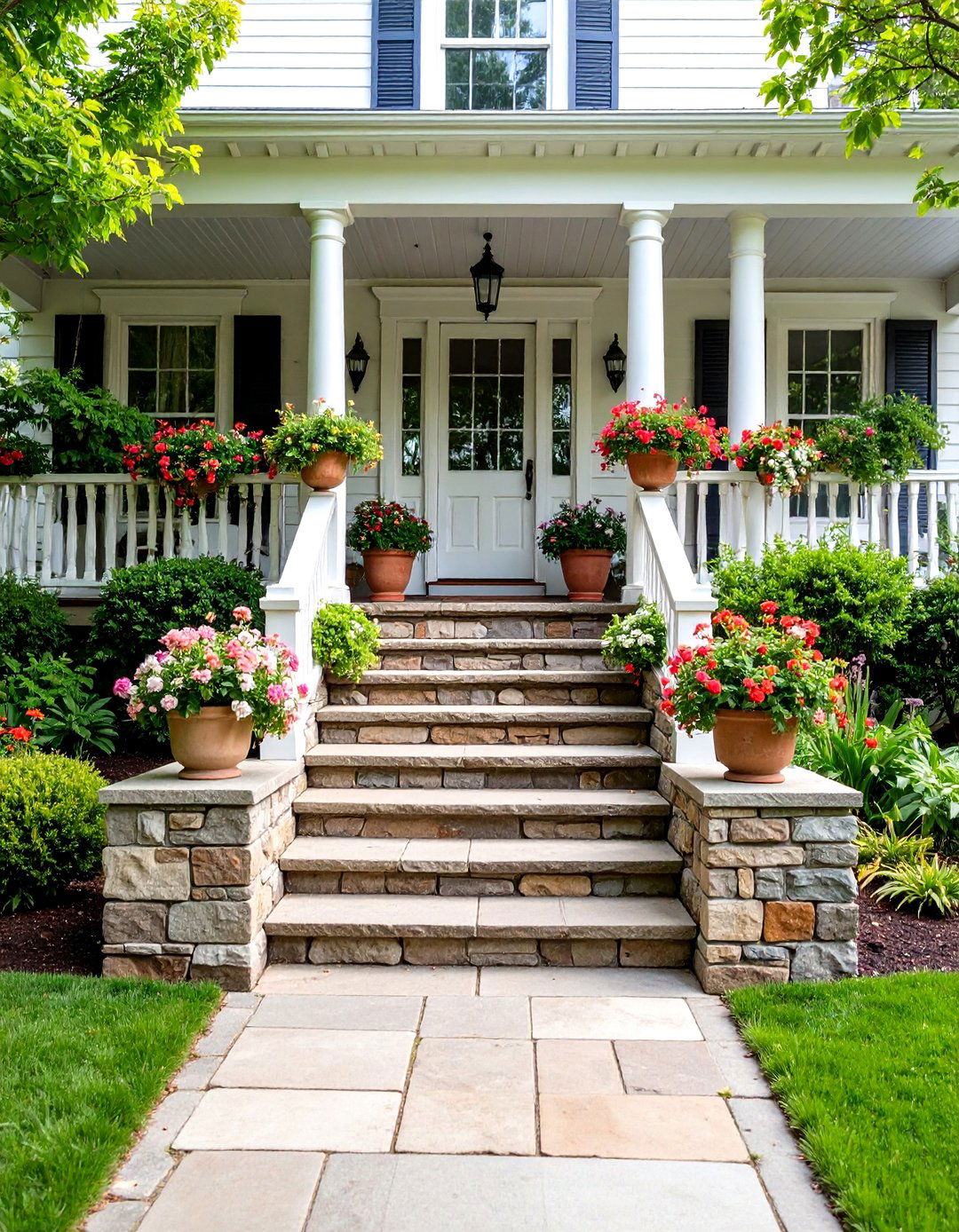
Create an impressive entrance with natural stone steps that provide durability and timeless elegance. Bluestone, granite, or limestone steps offer excellent weather resistance while maintaining the substantial appearance appropriate for colonial architecture. Design steps with generous proportions—typically 6-inch risers and 12 to 14-inch treads—that provide comfortable access and accommodate multiple people. Consider flanking the steps with low stone walls or planters that integrate with the overall design. The stone should complement your home's foundation material and color palette while providing adequate non-slip surface texture for safety. Proper installation with appropriate drainage and frost protection ensures these steps will age gracefully while maintaining their structural integrity and attractive appearance for generations.
16. Colonial Front Porch with Aluminum Column Systems
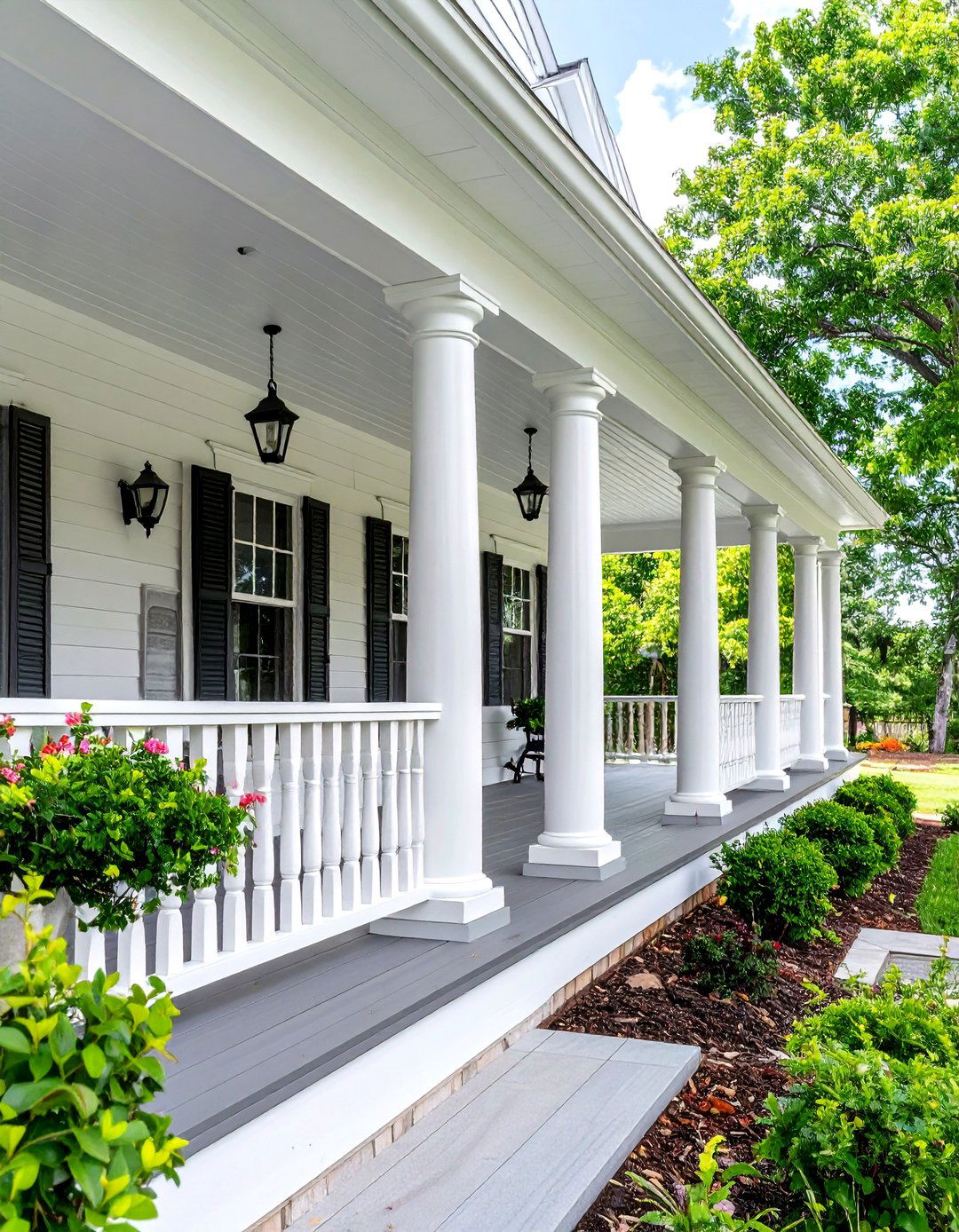
Modernize your porch structure with aluminum columns that provide the appearance of traditional materials with superior durability and minimal maintenance. These columns feature hollow construction with galvanized steel cores for structural strength, surrounded by weather-resistant aluminum shells that resist corrosion, insects, and moisture damage. Choose from various profiles including round tapered, square, or fluted designs that match historical proportions and details. Aluminum columns come in multiple paint finishes or can be field-painted to match your home's trim color. The lightweight construction simplifies installation while providing excellent load-bearing capacity for porch roofs. This modern material choice ensures your porch will maintain its appearance for decades without the periodic painting, repair, and replacement cycles required by traditional wood columns.
17. Colonial Front Porch with Traditional Color Schemes

Design a cohesive color palette that honors colonial traditions while reflecting contemporary preferences. Classic combinations include white siding with black shutters and a red front door, or cream body color with forest green accents and natural wood door staining. Consider soft gray siding with white trim and navy blue door details for a sophisticated modern interpretation of historical colors. The porch ceiling traditionally appears in sky blue or white, while porch floors can be painted in soft gray or left as natural wood stain. Limit your palette to three main colors plus one accent color to maintain the restrained elegance characteristic of colonial design. These color choices should complement your home's permanent elements like roofing and stonework while creating visual harmony across all architectural features.
18. Colonial Front Porch with Enclosed Screen Addition
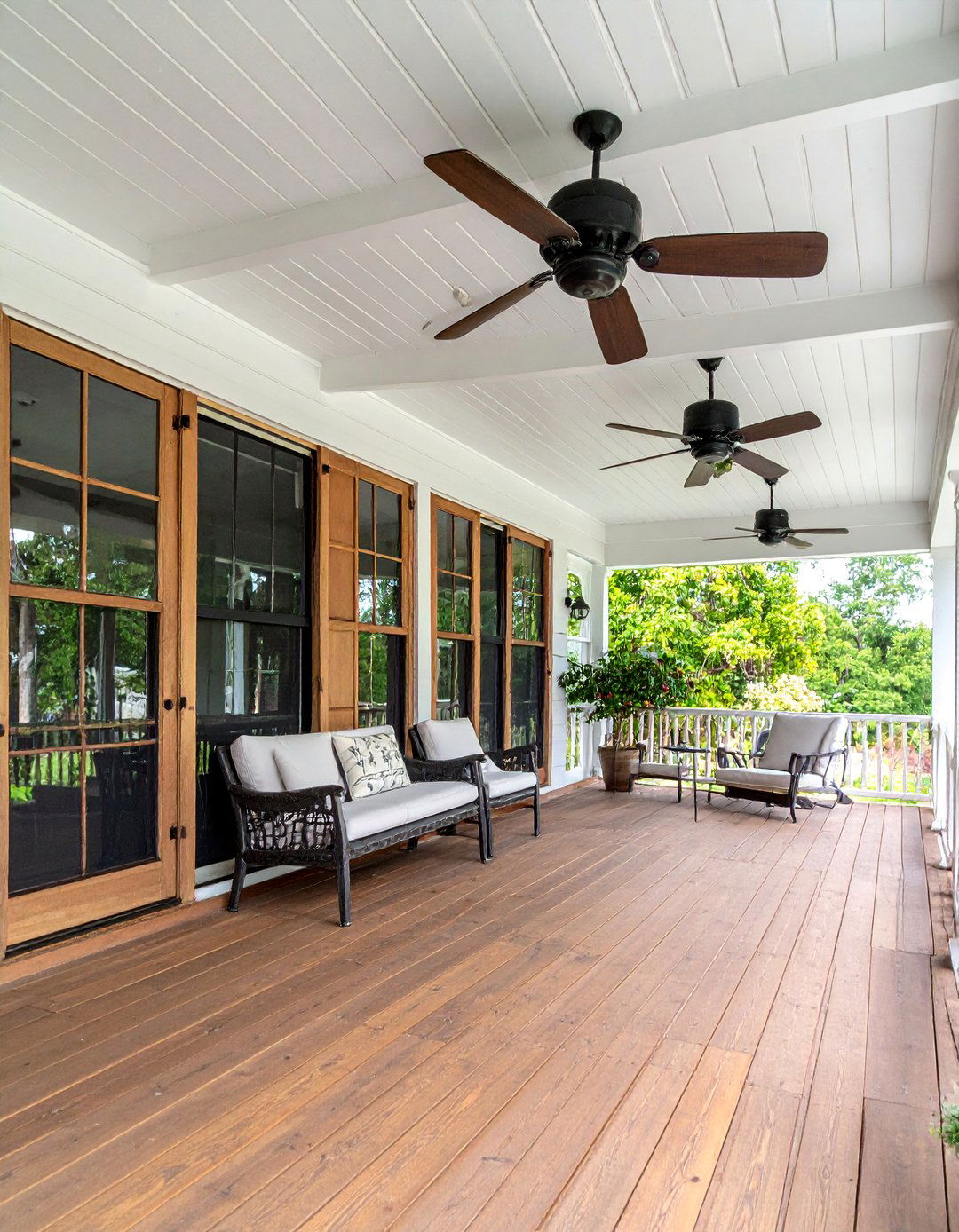
Transform your open porch into a screened outdoor room that provides insect protection while maintaining colonial character. Install screen panels between existing columns using traditional storm door screening in bronze or charcoal colors that blend discretely with porch details. The screening should be framed with simple wooden frames that match porch trim, avoiding ornate Victorian-style screen doors that conflict with colonial aesthetics. Include a screen door that opens outward to maximize interior space, positioned to align with your home's front door for visual continuity. Add ceiling fans for air circulation and consider installing removable glass panels for three-season use. This adaptation extends your porch's usability while preserving its historical character and providing comfortable outdoor living space protected from weather and insects.
19. Colonial Front Porch with Period Hardware Accents
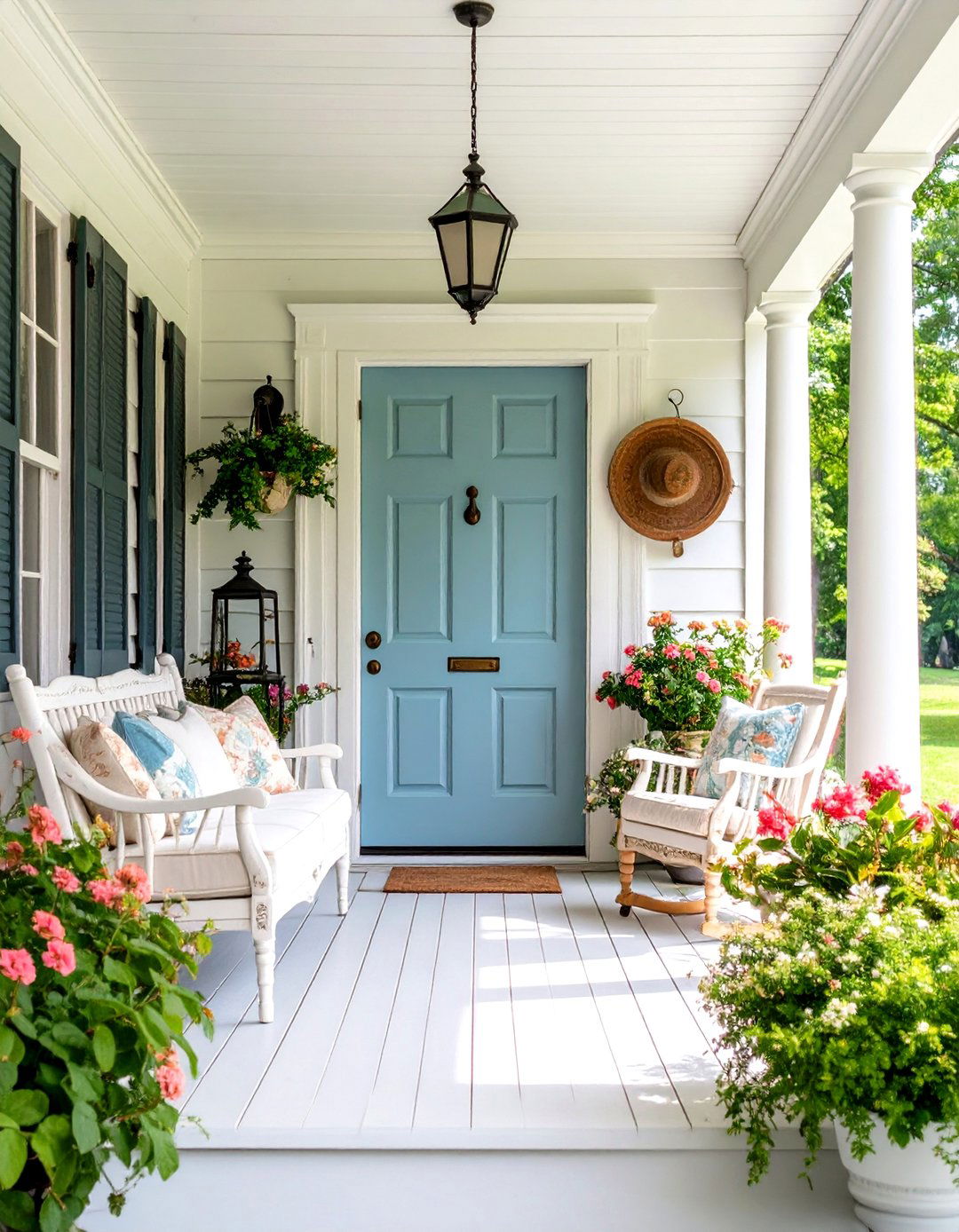
Complete your porch design with authentic hardware details that reinforce the colonial aesthetic throughout all functional elements. Choose door hardware in oil-rubbed bronze, antique brass, or black iron finishes that complement your home's overall color scheme and historical character. Install strap hinges on shutters, thumb latches on doors, and decorative brackets for hanging planters or lanterns. Porch furniture should feature traditional joinery techniques and hardware that reflects colonial craftsmanship, such as mortise and tenon joints secured with wooden pegs or hand-forged iron bolts. Even practical elements like mailboxes, house numbers, and porch hooks should echo colonial design principles with simple forms and appropriate materials. These details create cohesive design continuity that enhances your porch's authentic historical character.
20. Colonial Front Porch with Modern Comfort Integration

Blend historical charm with contemporary amenities by thoughtfully incorporating modern conveniences that enhance livability without compromising colonial character. Install outdoor ceiling fans with traditional styling to provide air circulation during warm weather, choosing models with wooden blades and antique-finish motors that complement your porch's aesthetic. Add discrete electrical outlets hidden within column bases or beneath railings to accommodate lighting and small appliances. Consider radiant heating elements beneath porch floors for extended seasonal use, or install retractable awnings that provide adjustable shade while maintaining clean lines when not in use. These modern additions should be implemented subtly, prioritizing functionality while preserving the timeless elegance that makes colonial front porches enduringly appealing to homeowners seeking both historical authenticity and contemporary comfort.
Conclusion:
Colonial front porches represent the perfect marriage of historical elegance and practical outdoor living, offering timeless design solutions that enhance both curb appeal and daily life. From traditional fluted columns and farmer's porch designs to modern composite materials and integrated technology, these 20 ideas demonstrate how colonial aesthetics can be successfully adapted for contemporary needs. The key lies in respecting fundamental design principles—symmetry, proportion, and restraint—while thoughtfully incorporating modern materials and conveniences. Whether you're restoring an authentic colonial home or creating colonial character in a new build, these design approaches will help you achieve an inviting entrance that honors American architectural heritage while serving your family's lifestyle for generations to come.


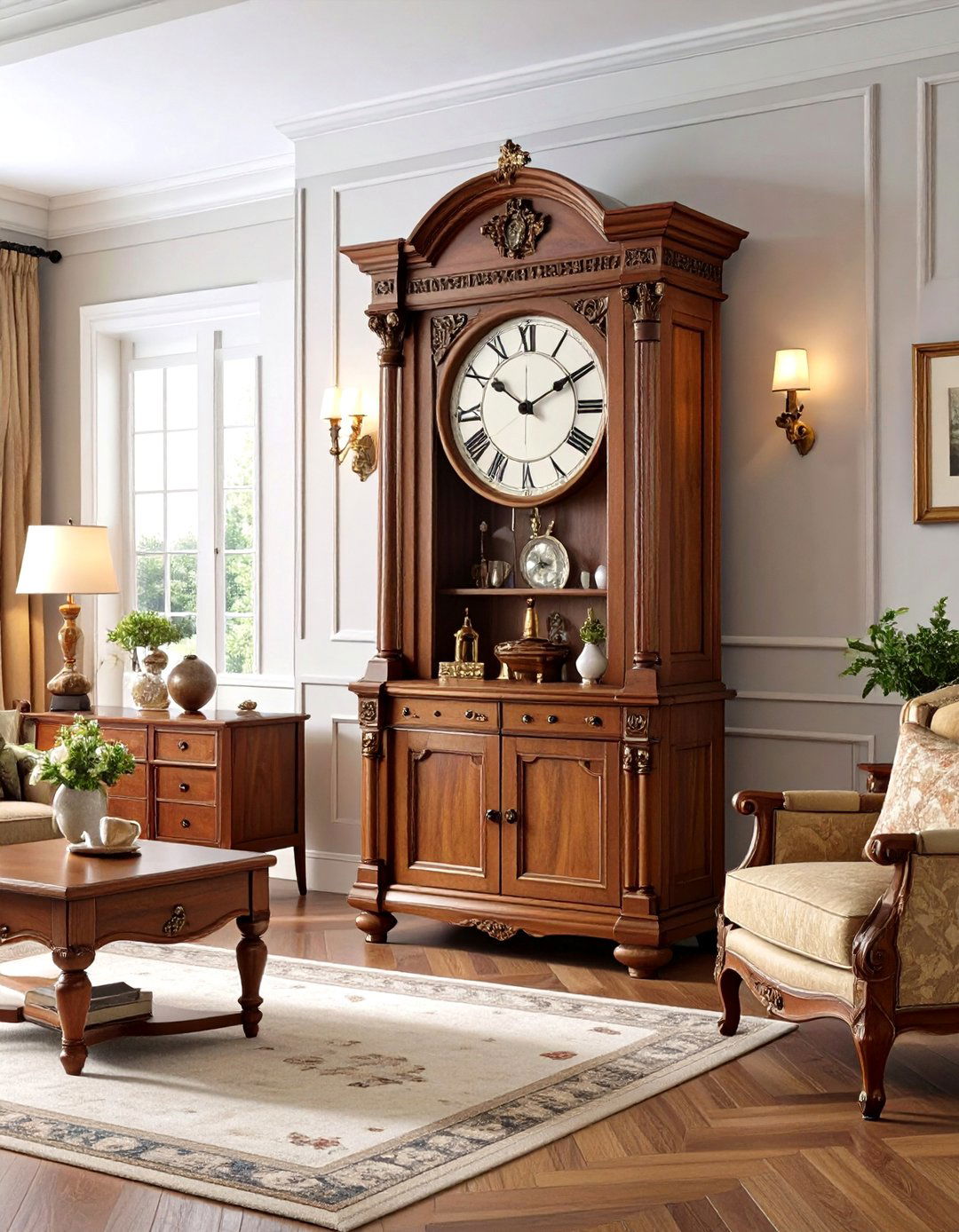
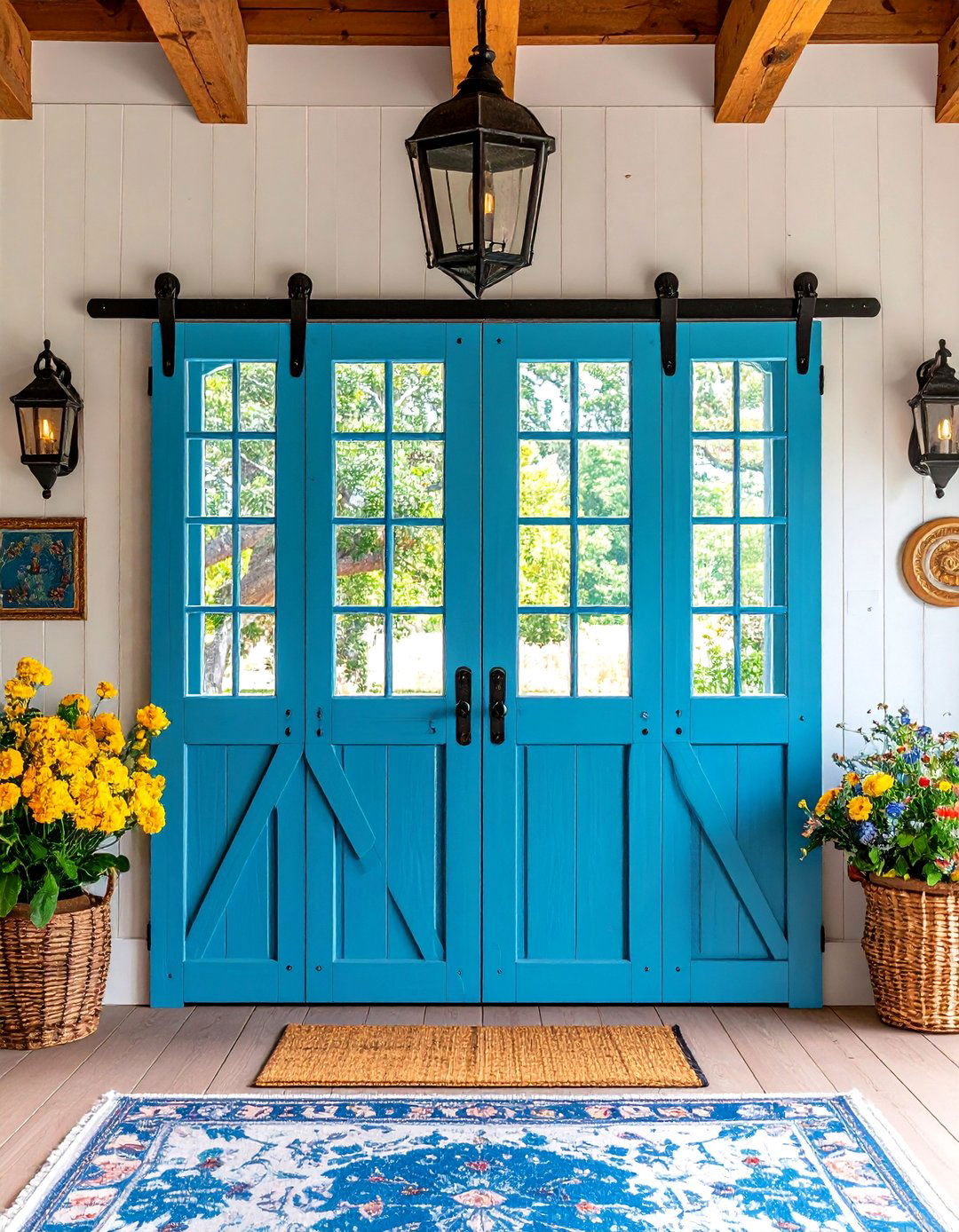
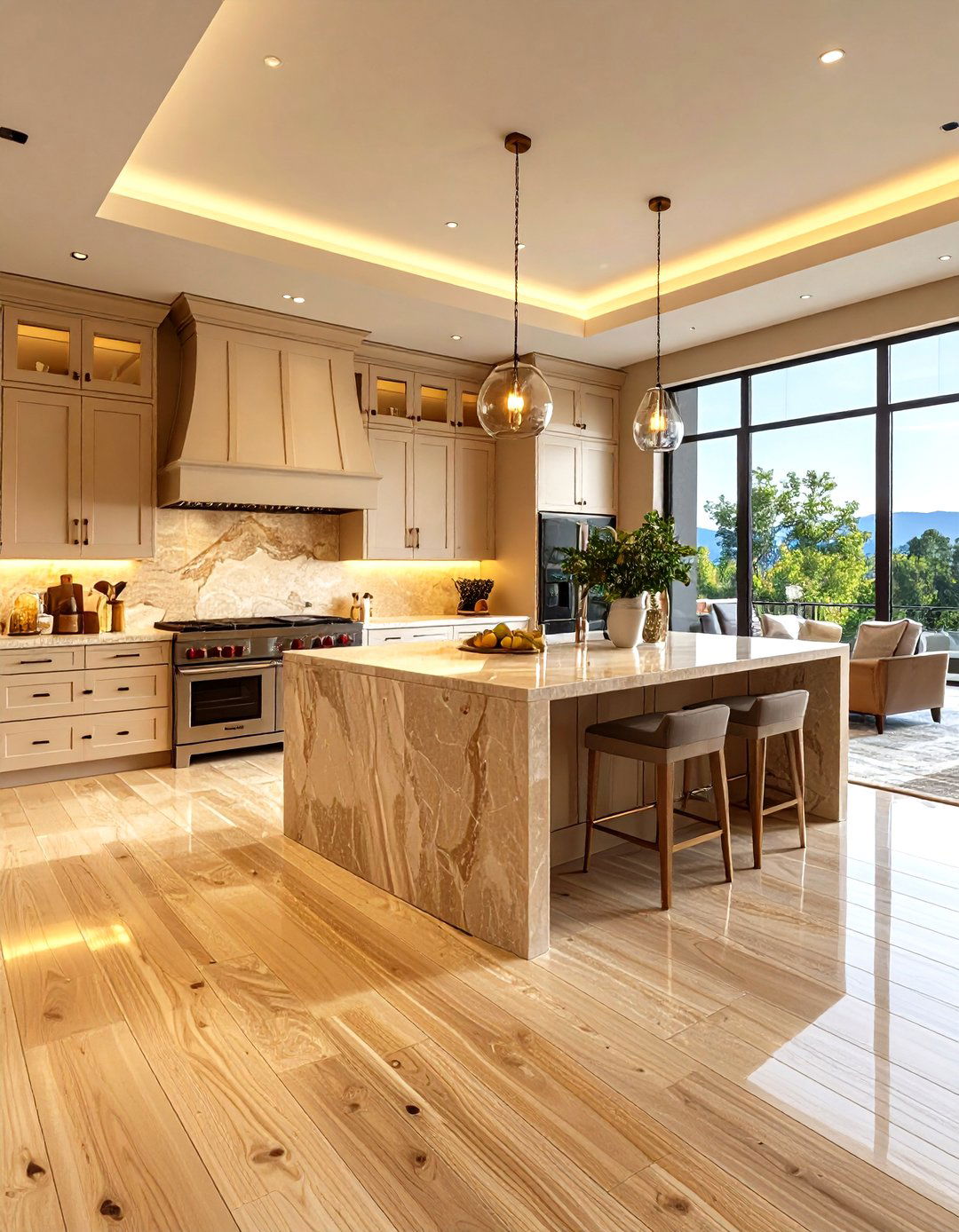

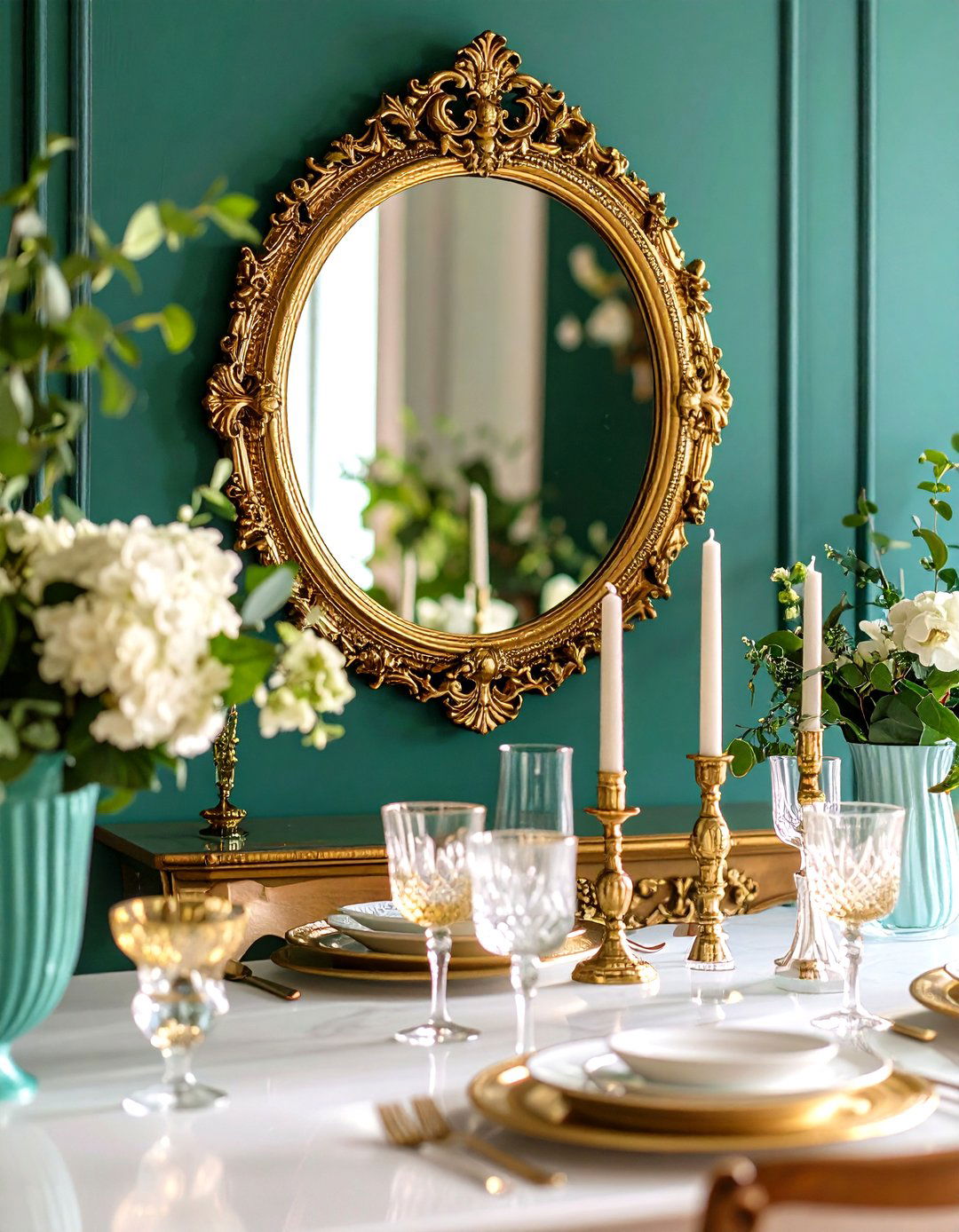
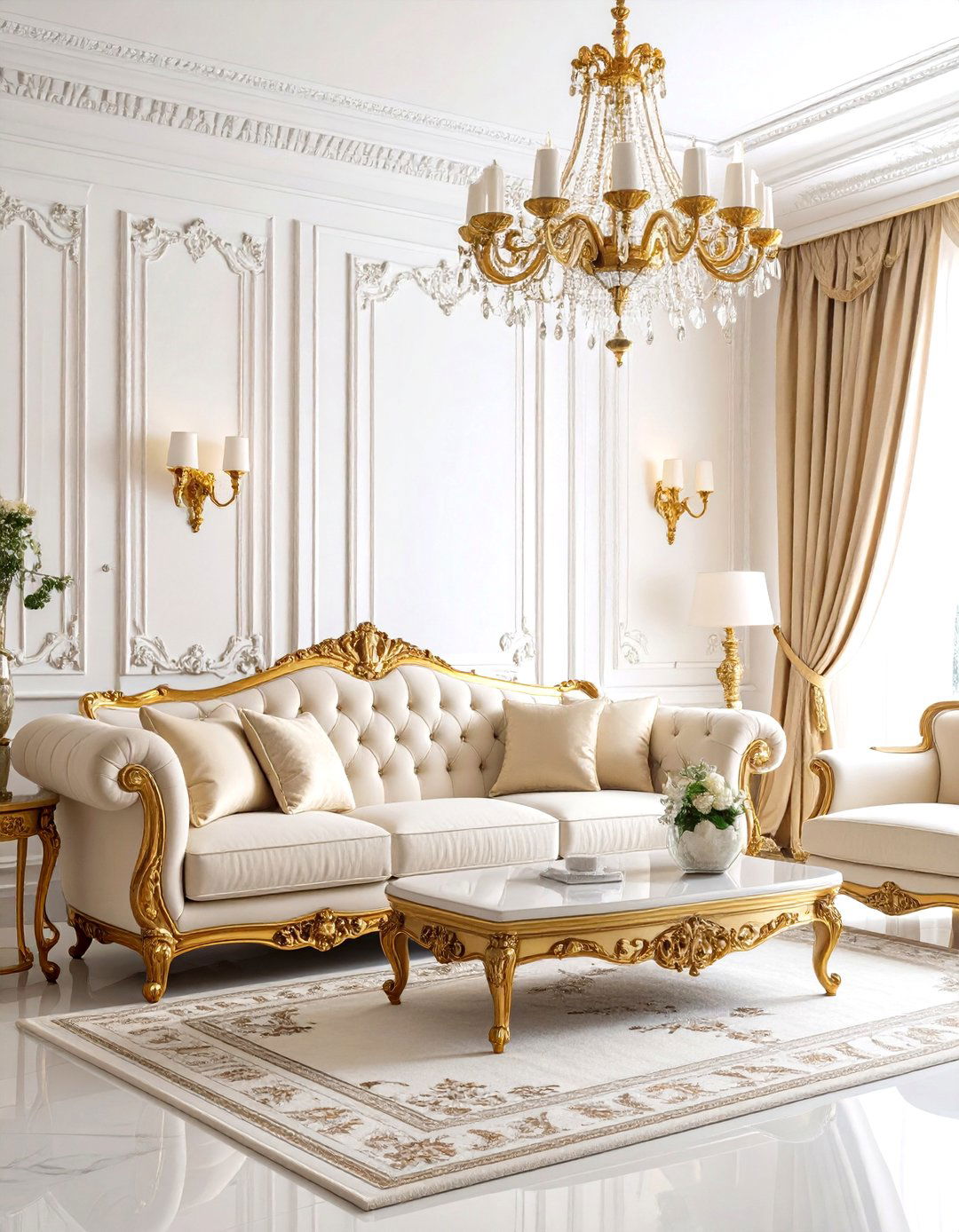
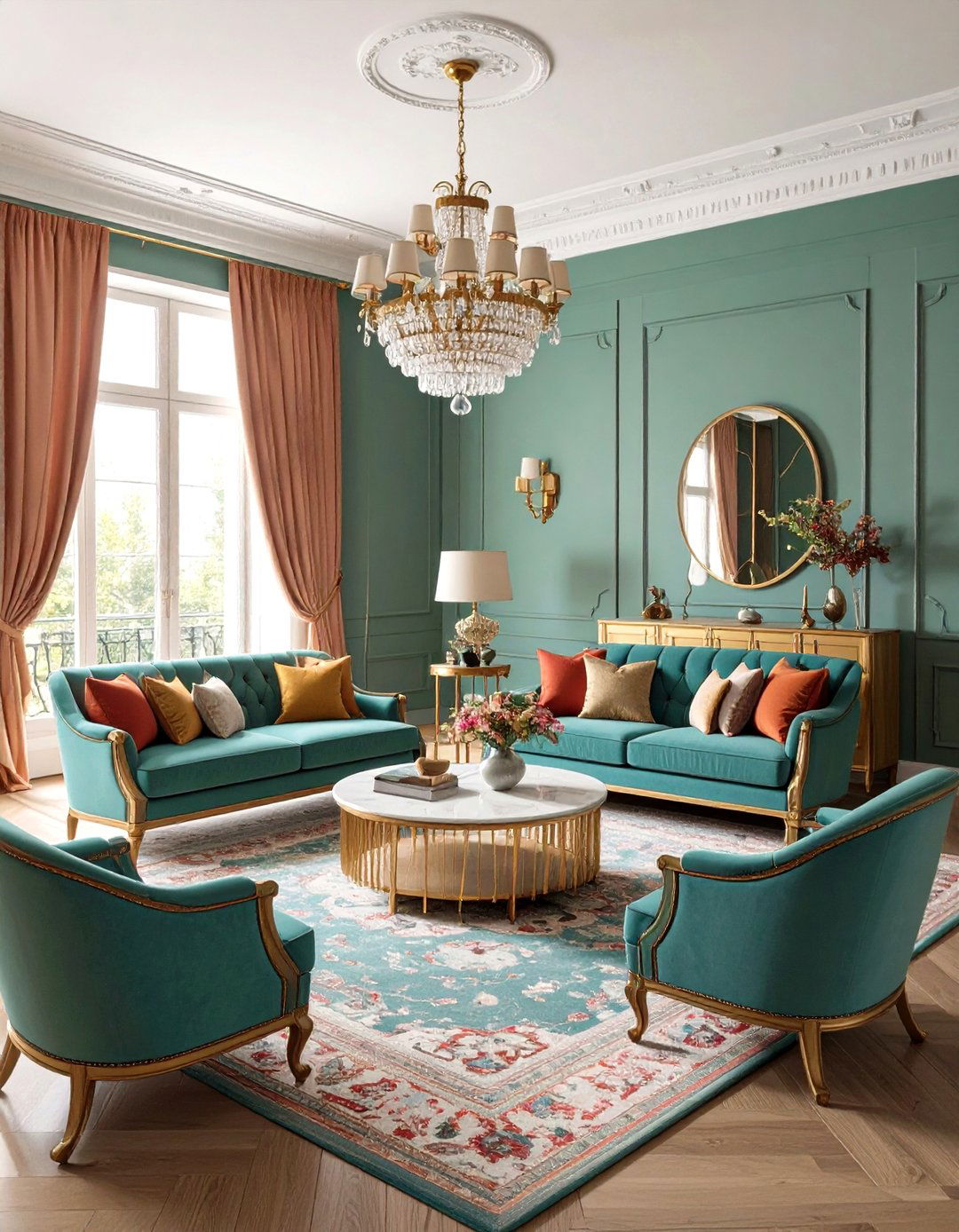
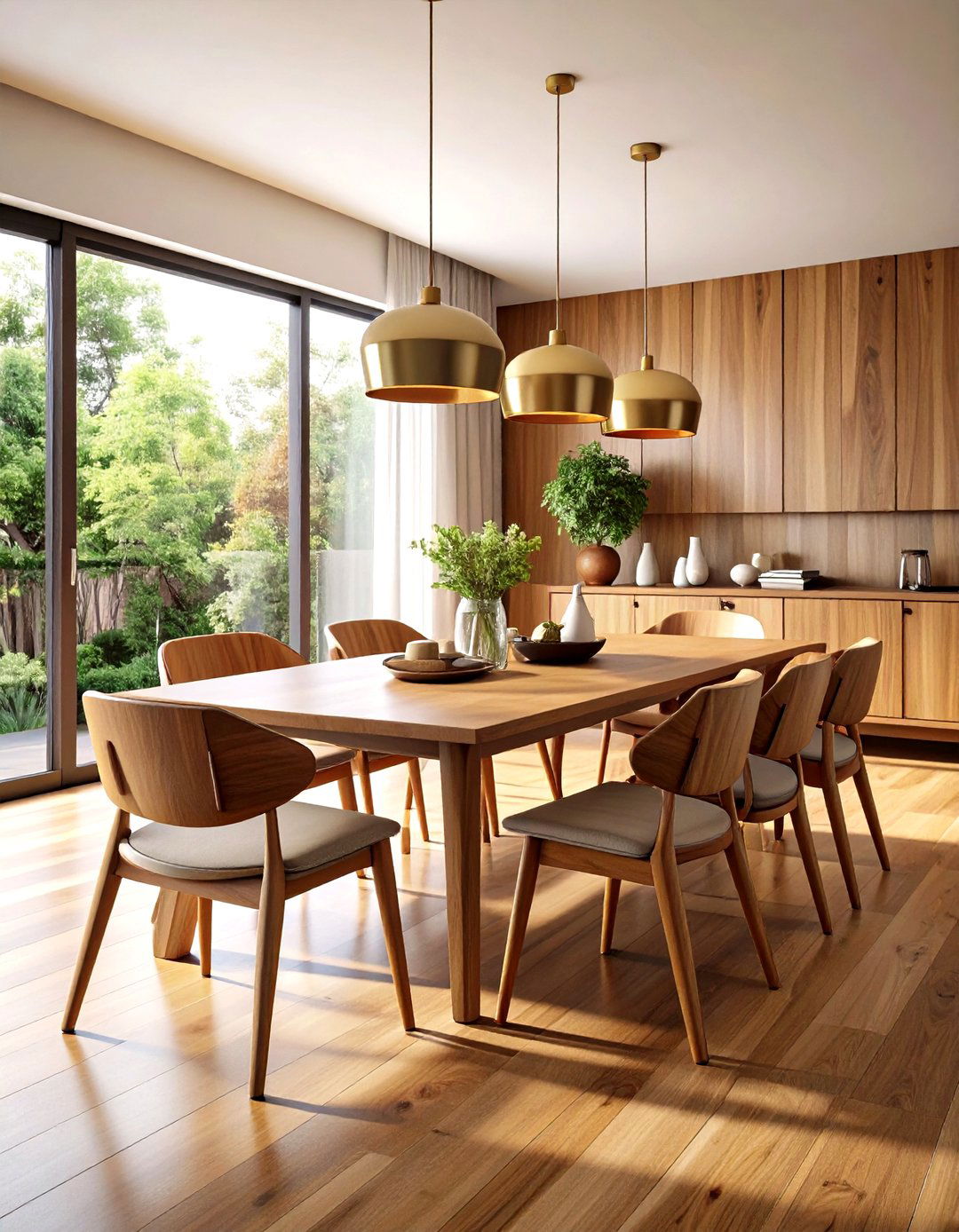
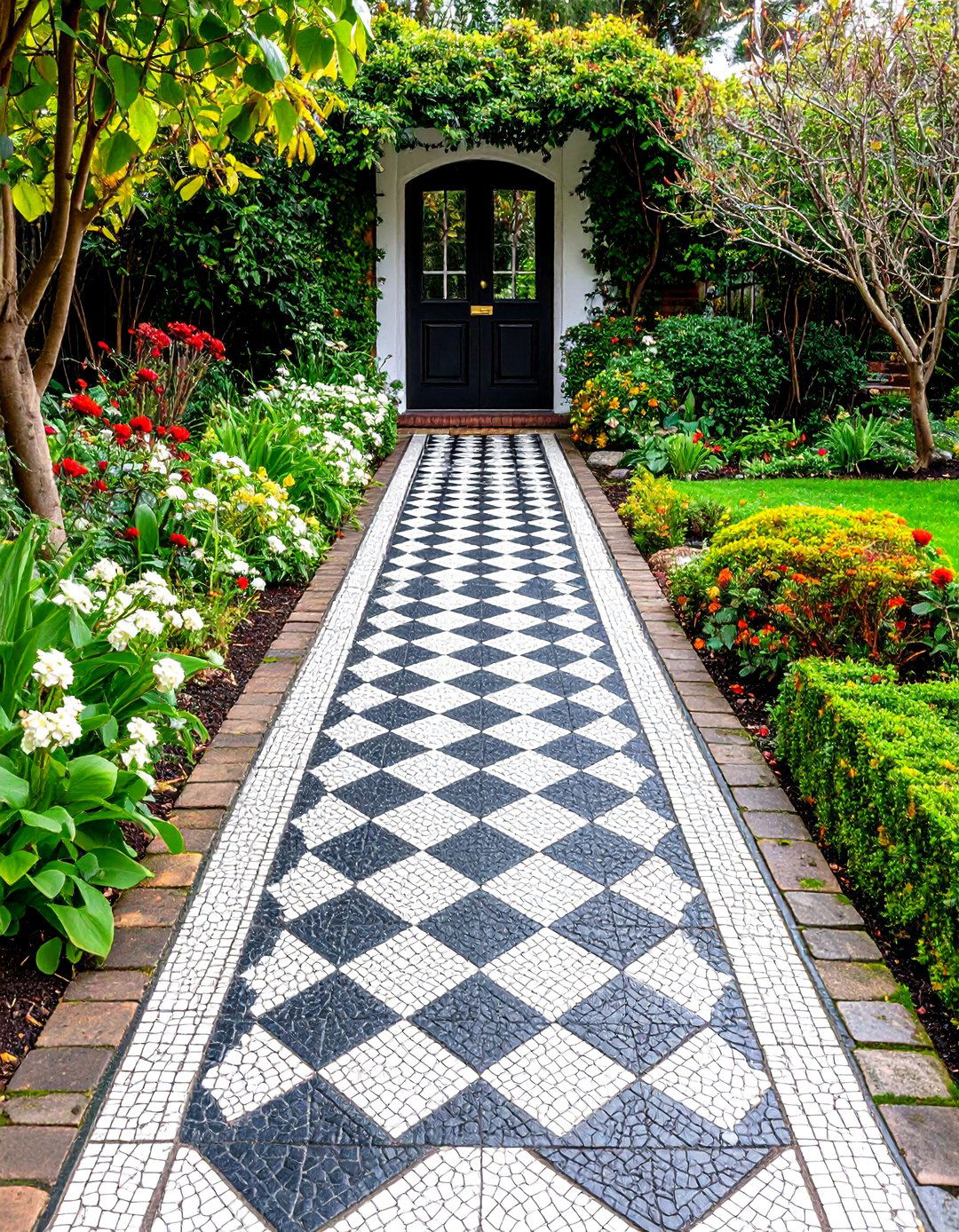
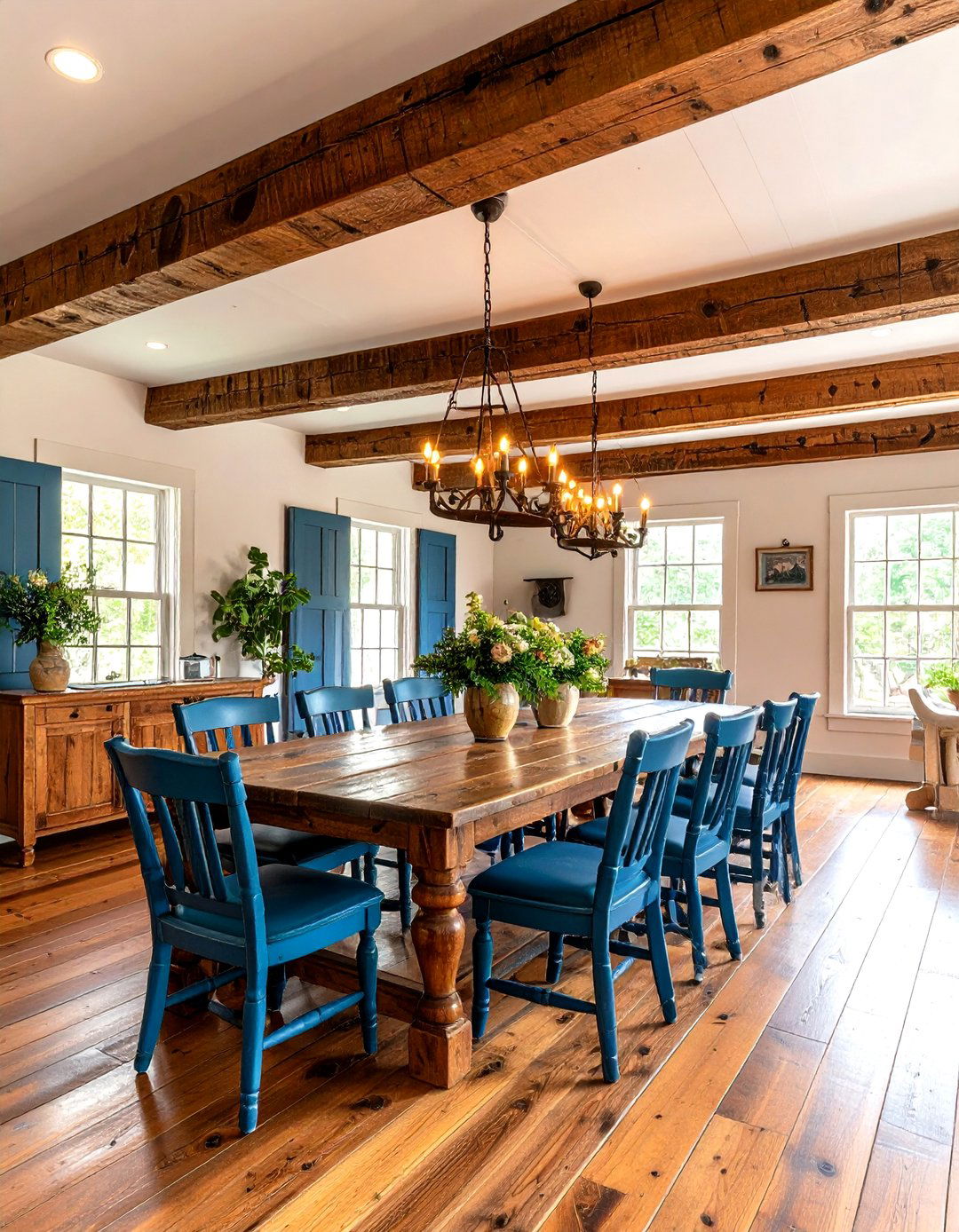
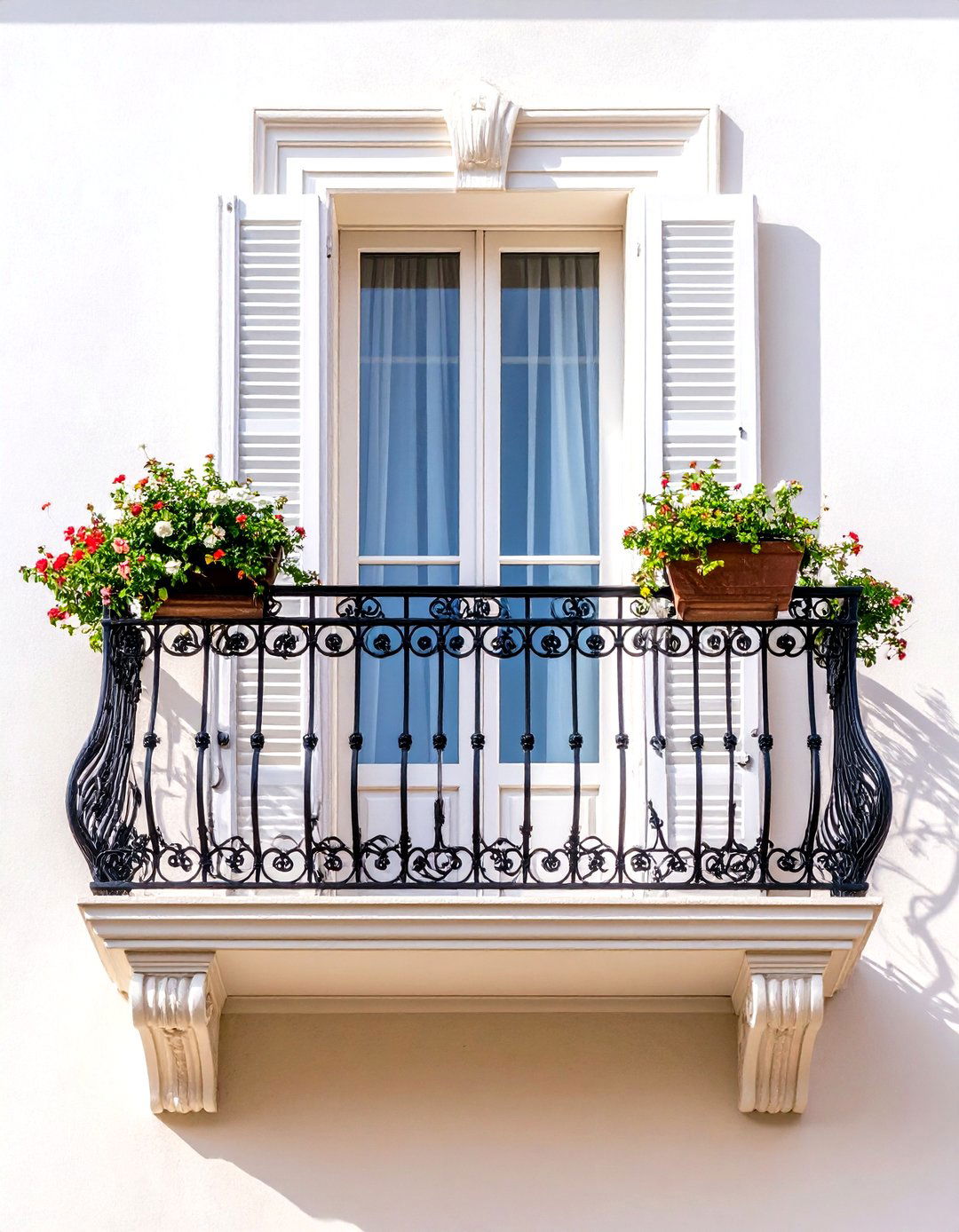
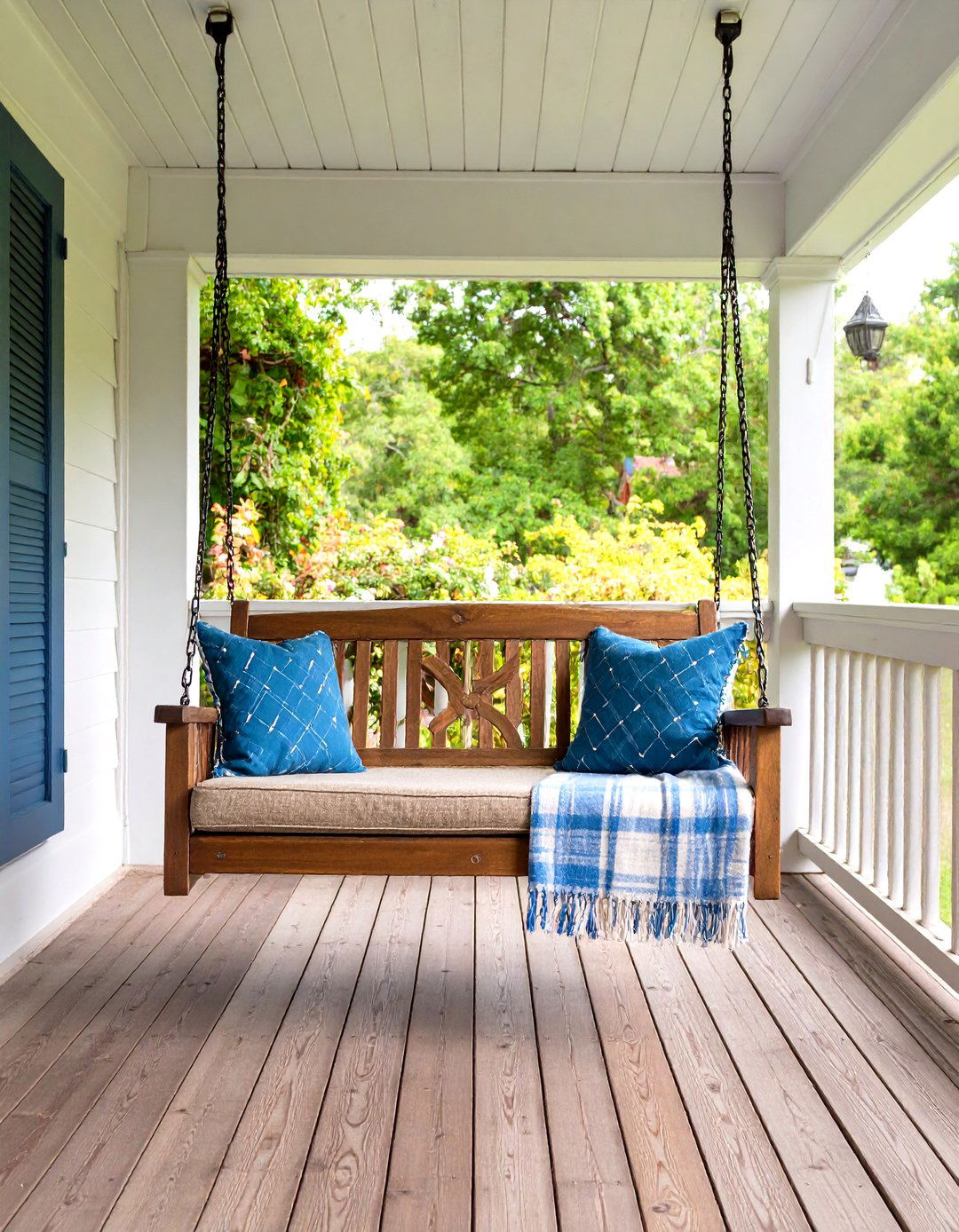
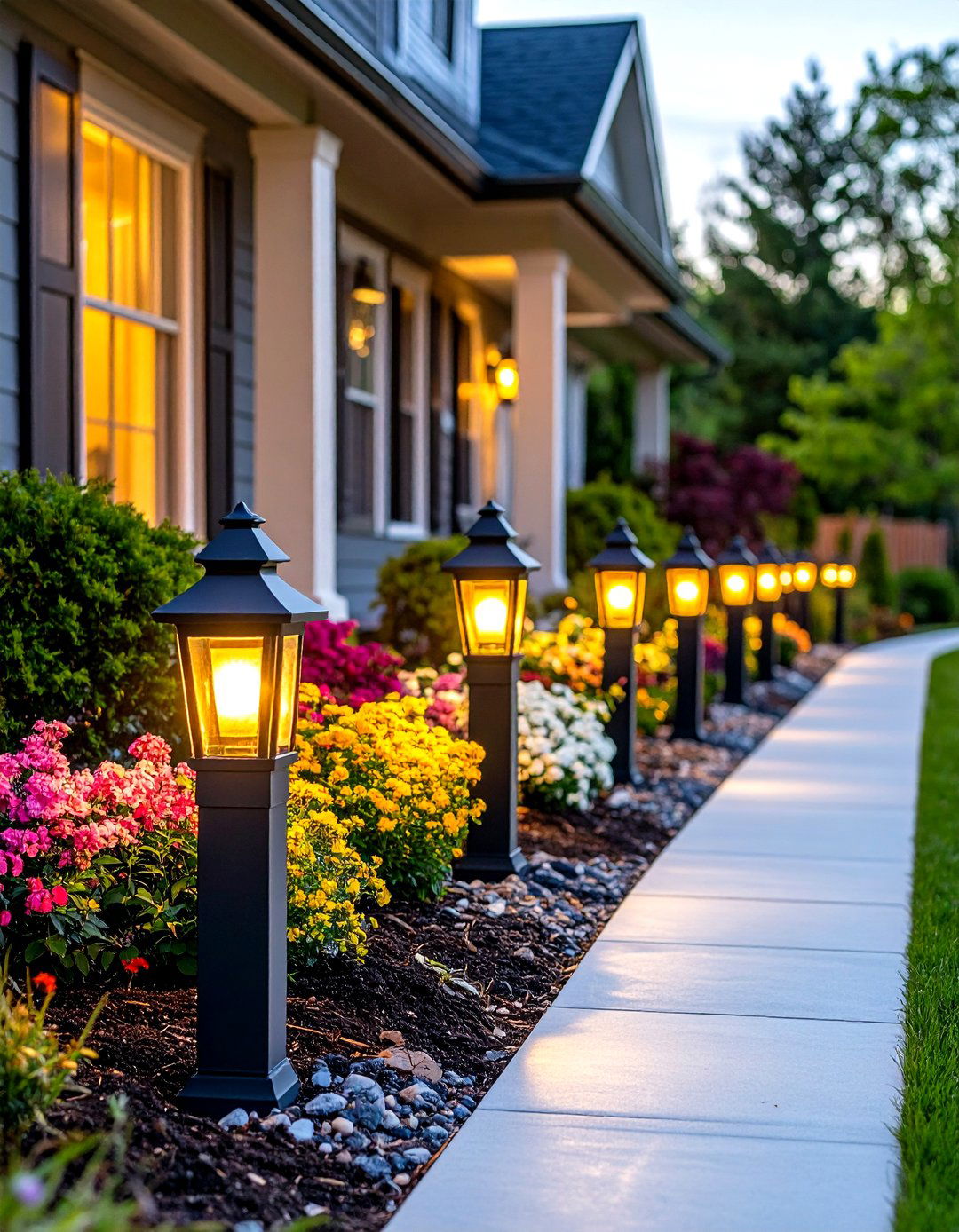


Leave a Reply